WEDNESDAY, MARCH 12,
Egg prices crack open political turmoil
Roxy Ekberg Politics Editor roxy.ekberg@dailyiowan.com
This is the first installment in a mulit-part series.
Bouncing down a grocery aisle in Iowa City’s Fareway on the east side of town, Kris Dougherty’s daughter dragged her family’s shopping cart over to the eggs.
Wedging her cart against the open air cooler, she tilted her head back to survey her options, the enticing packaging practically beaming in the cooler’s fluorescents.
She snagged a bright blue carton, lifted in the air, and called back to her dad.
“Can we get two?” she asked her dad, holding up a carton of eggs priced $6.99 for the dozen.
“No,” Kris Dougherty said. “Just the one.”
The Dougherty family buys a dozen eggs about once a week, he said, and the increasing cost of eggs hasn’t led to them making major budget adjustments. They have, however, had to cut back on some things.
“It’s ridiculous now,” he said, referring to the soaring prices of eggs.
The average price of a dozen large, Grade A eggs settled at $2.52 in January 2024 but skyrocketed to $4.95 a year later, according to the most recent data by the U.S. Bureau of Labor Statistics.
Dougherty isn’t alone in his frustrations. Confronted with rising egg prices, many Americans are adjusting grocery budgets to keep the kitchen staple in their shopping carts, including University of Iowa student Henry Kautz.
“It’s definitely just going to be something that I’ll look at in my budget every month and sigh about where the money is going,” the second-year mechanical engineering student said.
The cost of a carton has become a highly politicized issue and is one discussed far beyond Iowa City. Legislators and the president use the
“It’s definitely just going to be something that I’ll look at in my budget every month and sigh about where the money is going.”
Henry Kautz University of Iowa student
familiar item as a major talking point — especially when addressing the U.S. economy — causing eggs to roll into political rhetoric.
Republicans pushed the issue as a sign of former President Joe Biden’s failings, while Democrats now counter Trump is failing to deliver on his promises.
Kautz said the “gamesmanship” between the two political parties prevents them from talking about legitimate solutions to issues that impact the everyday working person.
“It just shows a complete lack of seriousness to actually add nuance or address issues that are very real and affecting common people in a way that has any merit,” he said. “It just turns into whenever one


Stuelke joins effort to curb online hate
The player looks to provide role models for young female athletes.
Grace Olson News Editor grace.olson@dailyiowan.com
Almost always seen on the court with a bright smile across her face, Iowa women’s basketball player Hannah Stuelke has earned herself the fan-created mantra: Happy Like Hannah.
However, the positivity Stuelke brings to the court is not always returned in the comments nor messages the third-year forward receives on social media.

permeates
Recent movies hide ageist stereotypes that seep into the real world. ARTS | 1C
On Jan. 21, 2024, Stuelke’s dad posted on X, formerly known as Twitter, that Stuelke had deleted her entire Instagram account after a disappointing loss to Ohio State due to the harmful comments she received within just an hour after the Hawkeyes left the court.
“There’s a lot of people out there who don’t understand how much work we put in and how hard it is mentally just to get through really difficult games,” Stuelke said in an interview with The Daily Iowan. “There’s a lot of keyboard warriors who will just get online and say whatever they feel, and they don’t understand how much it really affects us.”
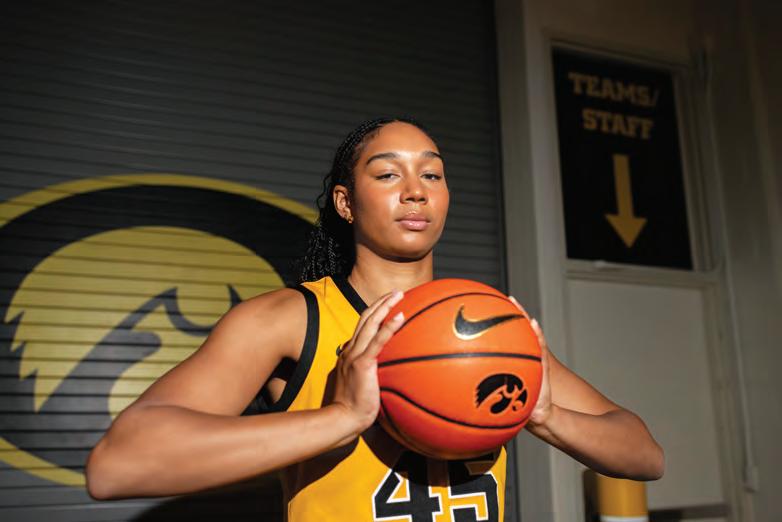
Isobel Perez News Reporter news@dailyiowan.com
The morning of Feb. 18 began like any other: students waking up and getting ready for classes. But for Olivia Oriho, alongside other students and resident assistants living in the University of Iowa’s identity-based Living Learning Communities, the day was disrupted by an email in her inbox announcing the university’s decision to no longer offer the Young, Gifted and Black LLC.
“We had all thought about the possibility that it was going to happen, but nobody was truly fearful of that happening,” Oriho, a first-year UI student currently living in the Young, Gifted
and Black LLC housed in Petersen Residence Hall, said. The UI’s LLCs are residence hall communities where students with similar interests or identities have the opportunity to live together and
“We had all thought about the possibility that it was going to happen, but nobody was truly fearful of that happening.”
Olivia Oriho University of Iowa first-year student
To address the culture of online negativity surrounding herself and her fellow female athletes, Stuelke has partnered with U.S. Cellular on a Name, Image, and Likeness, or NIL, campaign aimed at creating positive female role models for young girls and promoting positivity and celebration of women’s athletics.
Iowa State women’s basketball star Audi Crooks is also part of the campaign.
“There’s people like U.S. Cellular who want to get this message out, and partnering with them within NIL has been truly amazing,” Stuelke said. “Being able to speak to younger audiences and people who are just like me going through the same thing has been a great opportunity for me.”
Emma Calow, associate professor in the University of Iowa’s School of Journalism and Mass Communication, studies and teaches courses about inequities and social justice in women’s sports and female athletes’ portrayals in media.
Calow said female athletes’ accomplishments are often trivialized, and women are framed as not possessing natural athletic ability like men. Because of this, Calow said female athletes are three times more likely than their male counterparts to be the target of hate comments online.
“This cultural moment in which we’re in, in the context of women sports, it’s actually been driven by social media engagement by fans, male and female alike,” Calow said. “So, it’s interesting in that on one hand, we have social media playing as this vehicle for proliferating the celebration. On the other hand, the nature of social media also invites people to say what they want to say whenever they want to say it, reinforcing those dominant narratives that women are crappy athletes.”
As women’s basketball, specifically at the University of Iowa, has gained massive popularity in the last year due to the Caitlin Clark effect,
take courses related to their interests or identity. The LLCs provide a source of community and academic support for students, with All In serving LGBTQ+ students, Unidos serving Latine students, and Young, Gifted and Black serving Black and African-American students.
While the LLCs are open to all students, as described on the LLC website page of each identity-based LLC, the UI decided to eliminate the programs and has yet to comment on what this means for students currently living in the LLCs. Chris Brewer, the public relations manager with the Office of Strategic Communication, wrote in an email to The Daily Iowan confirming LLC | 5A
EGGS from 1A
he’s not doing what he promised, so don’t support him.’” Hagle said Democrats have used eggs as an indicator of how the economy is doing because the economy is a winning issue, as seen in the results of the 2024 election.
The rising prices, Hagle said, are more heavily linked to the bird flu creating supply issues rather than the economy and inflation.
Rattled by a bird flu outbreak, the egg market has been turbulent since 2022. The issue has only worsened in recent months. From November to December, the number of birds infected by the disease increased by more than 11 million and by nearly 5 million from December to January, according to data from the USDA.
“While the bird flu is not Trump’s fault, the rising prices are his problem politically,” Hagle said.
Eggonomics: the economy behind egg prices
Egg prices rose more than 15 percent from December to January, jumping to the largest increase in 10 years. The jump accounted for twothirds of the total food increase, according to the most recent Consumer Price Index report by the U.S. Bureau of Labor Statistics.
Between January 2024 and January 2025, egg prices rose by 53 percent, according to data from the USDA. The department predicts egg prices will increase more than 41 percent in 2025.
These skyrocketing prices can be attributed to three rather simple factors, according to UI economics professor Anne Villamil: bird flu, potential price gouging, and overall inflation and supply chain disruptions.
Villamil said while the process of killing millions of egg-laying chickens is the best way to prevent the spread of the highly pathogenic disease, it created a negative supply stock.
“From the point of view of economics, when you decrease the supply of anything, the price is going to go up,” Villamil said. “So, in that sense, it’s a very clear economic phenomenon.”
Price gouging may not be as likely as a culprit for rising prices, Villamil said, yet Democrats are calling for an investigation into pricing practices in the industry.
The Department of Justice opened an investigation on price gouging by major egg companies on March 7. The investigation targets large-scale producers, such as CalMaine Foods based in California and Rose Acre Farms based in Indiana. Cal-Maine is the largest producer and marketer of eggs in the U.S., followed by Rose Acres Farms and Daybreak Foods
Three years ago, the two companies paid $17.7 million to plaintiffs in a lawsuit alleging they participated in a conspiracy to limit the supply and

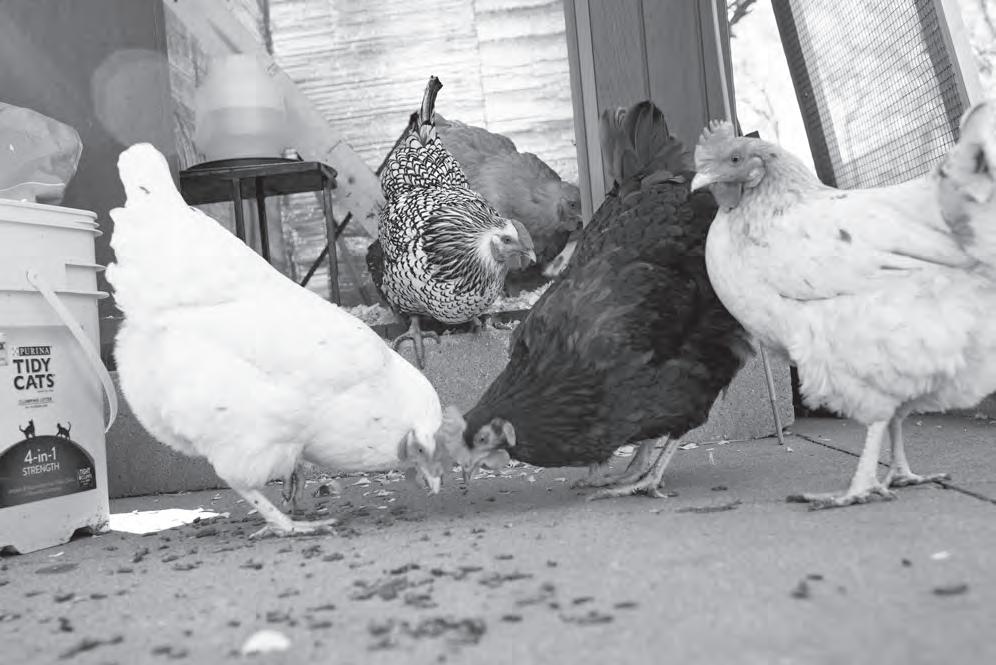
drive up the cost of eggs.
Villamil said inflation is currently on a downward trajectory, but there has still been inflation in food products. She said the country is at a stable place at this point in time, but some of Trump’s policies are very concerning, such as enacting a trade war with Canada and Mexico and increasing the
cultural economics professor, said looking back over roughly the past 50 years, egg prices do tend to move with the general economy. However, this correlation has not fit for the past couple of years.
The reason? Hart cited the bird flu.
“Avian influenza is hitting. This has nothing to
amassing impact
Nationally, in January alone, nearly 19 million commercial egg layers were affected by the avian flu, the highest monthly total since the outbreak began in 2022.
As the nation’s largest egg producer, Iowa has surpassed losses from avian flu in other states,
“Every retailer right now, we’re in a reactionary time right now. We’re all having to react to the supplies and the price points, and we still are trying to give our customers the best possible value that we can offer on eggs, because they’re so important .”
Elias Johnson Fareway spokesperson
country’s deficit spending rather than bringing it down.
“It is amazing, the flurry of policies and then policy changes. There is a tremendous amount of uncertainty in the economy right now,” she said. “I would like to see more certainty and more stable policies.”
Chad Hart, an Iowa State University agri -
do with the general economy,” Hart said. “In fact, the general economy has been growing but relatively slowly, yet we see these incredibly strong prices-wise because avian influence is overriding just the general, normal way the egg market responds to economic forces.”
Avian influenza’s
BIRD FLU DETECTED IN 46 OF IOWA’S COUNTIES
The U.S. Centers for Disease Control and Prevention reported the disease in 46 Iowa counties as of Feb. 27.

with nearly 30 million birds destroyed, according to the USDA. As of Feb. 27, the U.S. Center for Disease Control and Prevention reported the disease in 46 Iowa counties.
Yuko Sato, an Iowa State University veterinary professor and avian expert, said the current strain of avian flu is different from the strain in 2015. The current strain is an H5N1 virus, a type of avian influenza virus that can infect birds, mammals, and humans.
Sato said the magnitudes of the two outbreaks are vastly different. In 2015, Sato said the USDA Wildlife Service reported 71 detections of the virus
in wild birds. Through the current outbreak, from 2022 to now, the service has recorded over 12,000 detections in wild birds.
“The floor is lava,” Sato said. “There’s quite a bit of virus out there in the environment, and it’s really hard to prevent against something that’s all abundant there.”
The 2015 outbreak was a lapse in biosecurity, Sato said, and the industry has stepped up protocols, severely reducing farm-to-farm spread during the current outbreak. Sato said that in 2015, 80 percent of the cases where the virus was detected were from farmto-farm spread. Now, less than 15 percent of the cases are caused by this.
Sato said anxiety and bias may lead people to think farmers are swaying the prices, although this isn’t true and the cost increase is driven by the commodity market.
Stores boost prices, IC grocer keeps the same
Stores across the nation, including those here in Iowa, are boosting egg prices as a result of decreased supply. Many grocery stores have raised prices or set limits on how many eggs a customer can buy.
Grocery chains including Trader Joe’s and Aldi have begun limiting the number of
Sports Editor Colin Votzmeyer colin.votzmeyer@dailyiowan.com
Opinions
Audience Editor Shreya Reddy shreya.reddy@dailyiowan.com
DITV News Director Johnny Valtman johnny.valtman@dailyiowan.com
DITV Asst. News Director Jayce Bertrand jayce.bertrand@dailyiowan.com
DITV Sports Director Brady Behrend brady.behrend@dailyiowan.com
DITV Asst. Sports Director Collin Carrithers collin.carrithers@dailyiowan.com
DITV Tech Director Madison Johnson madison.johnson@dailyiowan.com
BUSINESS
cartons customers can pur chase. Coralville’s Trader Joe’s is enforcing a one carton per cus tomer policy, and Aldi in Iowa City currently has a two-carton limit.
Fareway has not implemented purchase limits but has had to increase egg prices to avoid negative impacts to overall business, Fareway spokesperson Elias Johnson said.
Johnson said the store has not implemented limits because they feel like they can meet the demand right now and haven’t seen an issue with supply, espe cially the more conventional white egg supply.
A dozen Grade A eggs are priced at $6.49 in eastern Iowa City’s Fareway.
“As far as pricing goes, we’re still trying to keep it as low as possible,” Johnson said. “But it gets to a point where you simply can’t take a loss for an extended period like we have been, and you have to adjust.”
Explaining the process that goes into deciding to increase prices, Johnson said the eggs Fareway buys from distribu tors are set at a price, and the store’s profit margins are very slim. Johnson said the store was taking a loss on eggs for over a month before having to adjust prices.
Johnson said despite the increase in price, Fareway has been consistent with egg sales and likely experienced an increase in sales due to public panic about dwindling supplies.

Hearing about a shortage sparks panic buying, Johnson said, which further complicates the issue, such as with toilet paper during the COVID-19 pandemic.
“Every retailer right now, we’re in a reactionary time right now,” Johnson said. “We’re all having to react to the supplies and the price points, and we still are trying to give our customers the best possible value that we can offer on eggs because they’re so important.” American Egg Board President and CEO Emily Metz said in a statement to The Daily Iowan the system for egg production is complex and time-sensitive.
Metz said the system is strained, bird flu remains a present risk to poultry flocks, and it will take a sustained period with no additional detections on egg farms to stabilize supply.
“The good news is that egg farmers have a lot of experience working together to move eggs across the country to where they’re needed most — and that’s exactly what they’re doing now,” Matz said in the statement. “We understand how frustrating it is when eggs are not available on a shopping trip, and we expect any shortages to be localized and short-lived as egg farmers work with their retail customers to replenish those stocks.”
While egg prices rise in Iowa City’s stores and throughout the nation, costs remain the same at locally owned and operated John’s Grocery.
As of March 6, a dozen Grade A, free-range, brown eggs cost $3.89 at the store in downtown Iowa City.
General Manager Chris Moore said the reason prices
are the same at John’s Grocery is because the store obtains its eggs from Farmers Hen House, an egg grading and distribution facility in Kalona, Iowa, that works with a collection of over 50 small farms.
Moore said the store switched to Farmers Hen House as a supplier during the pandemic when egg prices changed every week.
He said big box stores are reliant on other big companies, and if those companies change their price, they are at their whim, whereas John’s has more flexibility to make changes.
“We’re independent, so we’re not really locked in with anybody, and whenever we want to change, it’s not a big issue to,” he said.
The amount of eggs the store has purchased to sell has gone up by about 33 percent since the beginning of the year, Moore said.
Moore said other stores raising their prices is based on what’s happening in the political landscape, and it’s beyond the retailer’s control.
“I wish we had more control over it, but when the prices are raised to us, we raise the prices to the consumer,” he said. “That’s just the nature of the world.”
Buying chicks may not be the answer
U.S. Secretary of Agriculture Brooke Rollins encouraged people to purchase chickens to help combat the rising prices of eggs, in an interview with Fox News at the beginning of March.
“I think the silver lining in all
of this is, how do we in our backyards — we’ve got chickens, too, in our backyard — how to solve for something like this?” Rollins said in the interview. “And people are sort of looking around thinking, ‘Wow, well, maybe I could get a chicken in my backyard,’ and it’s awesome.”
Tractor Supply Co., the largest retailer of live poultry in the country and a leader in backyard poultry sales, reported selling 10 million chicks each year for the past several years — more than double compared to total chick sales 10 years ago.
Nicole Logan, senior vice president and merchandise manager at Tractor Supply Co., said in a statement to the DI that the company has seen interest in raising chickens grow for a while. In the past five years the number of annual customers who purchase poultry in the stores has increased by more than 50 percent.
“Egg prices certainly make people think about getting into this hobby, however, if you are just looking to save money on eggs, then backyard poultry is not a quick fix,” Logan said in the statement. It takes up to 22 weeks before chickens are mature enough to lay eggs, Logan said in the statement, and it is an investment of time and money to care for them.
Jennifer McCune, of Iowa City, began raising chickens last May and advises against purchasing backyard chickens for the purpose of cutting costs on eggs.
“I have to laugh when people say that they’re going to get backyard chickens to save
COST OF GRADE A EGGS EVERY JANUARY SINCE 2020
The U.S. Bureau of Labor Statistics compiled data showing the dips and spikes in the price of a dozen large Grade A eggs every year from January 2020 to now.
money because it doesn’t end up that way at all,” she said.
McCune crunched the numbers and found that with her initial $1,500 investment in the chicks, a coop, and all of the necessary supplies, she would need to sell 300 dozen eggs at $5 per dozen to break even.
However, because of Iowa City guidelines, urban chicken owners cannot sell eggs from birds that live in their backyard. Having backyard chickens in Iowa City requires filing for a permit, completing an application, and receiving a signed consent form from all neighboring property
owners.
McCune said there are cheaper options to pursue having backyard chickens, but she wanted to ensure her animals are safe from predators, warm and safe in the winter months, and properly taken care of.
“I would encourage anyone to try raising chickens, however, you’re not getting into it to make a dollar, especially in Iowa City,” she said.
“You’re not offsetting the price of eggs at the grocery store, and you are strictly getting chickens for pets, and an added bonus is you get food from them.”
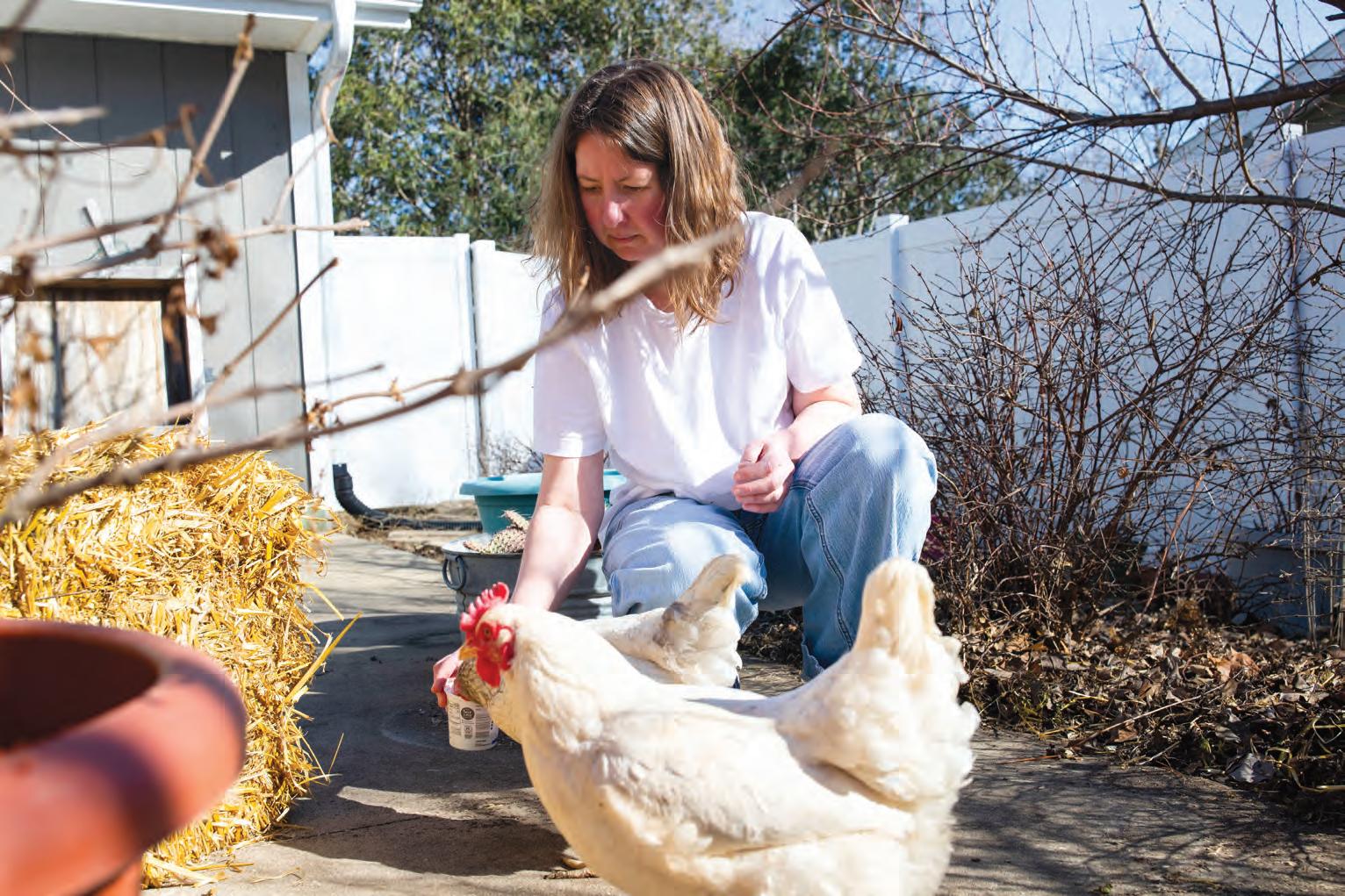
EDITORIAL
The White House: a Masterclass in propaganda
The White House social media has gone to gross lengths to glorify the president dehumanizing immigrants.
The Daily Iowan Editorial Board opinions@dailyiowan.com
“ASMR deportation Instagram reel.” Say that out loud. Say it slowly. Say it with a smile on your face.
You can’t.
Within the first month of Donald Trump’s presidency, the White House Instagram and X, formerly known as Twitter, accounts have posted various demeaning, contemptuous reels and images. On Feb. 18, however, the accounts posted, arguably, the most shocking content yet. The video, captioned “#ASMR: Illegal Alien Deportation Flight,” shows officers shackling immigrants’ hands and legs, lining them up, and escorting them on a deportation flight.
“To be soothed or entertained by the suffering of others speaks to the depth of your depravity,” Instagram user @king_ nk commented. And he couldn’t be more right. ASMR — a genre of sensory experience typically used to promote relaxation through sound — when paired with the trauma of human suffering, is deeply disturbing. Typically more popular with younger generations, ASMR might appeal to this demographic. It’s dehumanizing, and coming from an institution of such prestige and power, it is especially unsettling.
This is the White House, the symbolic heart of the U.S. government — a heart that is using a powerful communication tool to manipulate and exploit suffering for entertainment. Media of this manner desensitizes the public to violence against marginalized groups for mere entertainment and shock value.
“With our country being as polarized as it is, people are losing faith in institutions that once held prestige — the White House at the center,” Brett Johnson, associate professor in the University of Iowa’s School of Journalism and Mass Communication, said. “We now live in a world where a government office has

Elon Musk cooperating with Trump, these posts will further the inhumane rhetoric of the administration.
Since the start of Trump’s presidency, many users of Meta and X have reported censored material on their devices. The fact these tech moguls have close ties with Trump, or have publicly supported him, suggests certain types of content
This is the White House, the symbolic heart of the U.S. government — a heart that is using a powerful tool for communication to manipulate and exploit suffering for entertainment.
no political repression or boundaries on what they share.”
Yet, for the White House, social media isn’t the end. The official government website for the White House has further tainted its name. One article published states, “The Fake News losers at CNN immediately tried to fact check it, but President Trump was right (as usual).” The only word we can use to describe this sort of language is childish. Days after Trump’s re-election, the Spanish version of the White House website was taken down. Even in a society with free speech in the media, there must be a line. If we, as American citizens, demand a higher standard from journalists in sharing information, why shouldn’t one of the most powerful platforms of the nation act with the same integrity?
A problematic post should not be left unchecked, yet it will be on Instagram and X. With both Mark Zuckerberg and
EDITORIAL CARTOON
might be less likely to be moderated, even if that content is misleading. They are now the ones who decide what is worth censoring and what is dehumanizing, even if it is just their bias.
Despite these concerns, in his congressional address, Trump proclaimed, “And I have stopped all government censorship and brought back free speech in America, it’s back.” For a president signing legislation akin to censorship, denying oppositional media press access, and threatening to imprison protesters, the hypocrisy is undeniable. Free speech is now weaponized to silence dissenting opinions.
Less than 24 hours later, Instagram users were shocked by yet another post from the same account. “Long Live The King,” it said, with an illustration of Trump as a monarch.
For a country that was built on the rejection of monarchy and belief in popular sovereignty in its Constitution, depicting the president as a king is troubling.
Frankly, it undermines the foundations of the U.S. At Trump’s joint congressional address, his power over his supporters was apparent — and truthfully, almost king-like. With almost everything he said, the Republican delegation roared with applause and standing ovations.
This type of rhetoric doesn’t belong in a free society and is, ultimately, propaganda. We look to the president of the U.S. for leadership, not dominion, because we are a democracy. As of 2022, 64 percent of Americans viewed social media as a “bad thing” for democracy.
And so, when a platform uses its influence to spread propaganda that villianizes people of other races, we must take another look — especially into world history.
During both World War I and World War II, the U.S. government employed propaganda to rally support for military efforts. The term propaganda took on a less neutral tone in the early 20th century when information being disseminated began manipulating people’s outlooks on war and “the enemy.”
War advertising in the U.S. and France, often published by the press, aimed to demoralize German troops, associating
al that portrayed Jewish individuals as “vermin.” This material ranged across mediums including posters, movies, and sculptures. By dehumanizing the Jewish population, the Nazis were able to brainwash citizens into believing they were cleansing the world with genocide. But we aren’t in the 20th century anymore. It doesn’t take a genius to recognize similarities between such propaganda and the White House’s social media posts related to immigration as of late. It seems as if the recent posts are to distract us from the policy enactments across the nation. For a generation that has grown up historically informed, we cannot be provoked by the powerful. The “#ASMR: Illegal Deportation Flight,” treats immigrants as if they are not humans with feelings and instead uses them for the warped entertainment of audiences.
The social media of the U.S. Immigration and Customs Enforcement, or ICE, furthers this rhetoric by reporting daily updates on the numbers of immigrants detained and arrests of “The Worst First.” These immigrants are individuals who are
If we, as American citizens, demand a higher standard from journalists in sharing information, why shouldn’t one of the most powerful platforms of the nation act with the same integrity?
them with images of “barbarians” and making Allied powers out to be heroes. This same concept later applied to World War II when Nazis distributed materi-

STAFF
Jami Martin-Trainor | Executive Editor
Columnists: Cole Walker, Muskan Mehta, Abigail Jones, Caden Bell, Reese Thompson, Grace Dabareiner, Julia Anderson, Aaron El-Kadani, Kennedy Lein, Jackson Mendoza
Editorial Board: Jami Martin-Trainor, Marandah Mangra-Dutcher, Jack Moore, Stella Shipman, Muskan Mehta, Charlie Hickman
COLUMNS, CARTOONS, and OTHER OPINIONS CONTENT reflect the opinions of the authors and are not necessarily those of the Editorial Board, The Daily Iowan, or other organizations in which the author may be involved.
EDITORIALS reflect the majority opinion of the DI Editorial Board and not the opinion of the publisher, Student Publications Inc., or the University of Iowa.
suspected of committing violent crimes. All of these posts share one thing important in common: They never refer to these individuals as people. They are “criminals,” “detainers,” “illegal aliens,” the “worst.”
“The last thing anyone who is hawkish about immigration wants to do is put a human face on an immigrant,” Johnson said. “We even see this when people use natural terms like a ‘flood’ or a ‘wave’ of immigrants. It just conjures an impersonal stance, making it easier for these policies to be enacted.”
Language is a tool that sets boundaries — or in this case, removes them. Videos, tweets, and posts are all decentralized forms of communication that can impact political and social views. With over 8 million followers on Instagram, the White House account has the same influence.
As a country previously nicknamed the “Melting Pot” and a “tossed salad” for its welcoming nature to diversity, referred to as a nation built by immigrants, America has changed. With ICE around the corner nearly everywhere and with the biggest platforms like Instagram and X spewing propaganda against them, immigrants are not safe in the U.S.
So, we must stay vigilant. When traditional media like broadcast, newspaper, and radio, dominated our public discourse, it was easy to spread a broad message. Now, with social media, people can micro-target these messages, making them harder to fact-check because of the lack of eyes on them before publication. But we must fact-check. Being literate in the media is vital to avoiding misinformation and irresponsible content.
the decision to eliminate the LLCs but had no further comments on the matter.
But students are not satisfied with the response.
With the email students received, their worries were confirmed as they were informed the three identity-based LLCs — All In, Unidos, and Young, Gifted and Black — would no longer be offered in the 2025-26 school year because of a letter released by the U.S. Department of Education Office for Civil Rights.
The “Dear Colleague” letter stated discrimination based on race, color, or national origin is illegal and explained how these discriminatory practices have been justified under the organizational framework Diversity, Equity, and Inclusion.
The U.S. Department of Education Office for Civil Rights stated DEI programs, because of their consideration of race and identity, are discriminatory and educational institutions must dismantle these programs. This letter was linked in the email sent to students to explain the university’s decisions.
Lauren Jackson, a resident assistant in Rienow Residence Hall, also received the email from Housing and Dining. Jackson was
a member of the discontinued public health LLC during her first year at the UI dto Young, Gifted, and Black and the academic support it would provide her as the first in her family to enter the science and medicine field. As an RA, she was also included in the emails sent to those in the LLCs and said she was surprised and saddened by the news.
“I definitely was kind of shocked that things were happening so quickly,” Jackson said. “I thought there would at least be an effort to reframe and find another way to have these spaces available before talking about totally dismantling and canceling these Living Learning Communities.”
Jackson said she was sad the Young, Gifted and Black would be eliminated, especially considering it was only formed in 2016 and wouldn’t be able to celebrate a decade mark as a community space.
“I would have wanted more of a fight. Like, fight for your students, fight for your underrepresented population more,” Jackson said. “I understand this is the government, but are there ways to reframe? Are there ways to bring them back eventually? Like, these are the conversations that we’re wanting to see.”
For both Jackson and Oriho, the community spaces provided by the identity-based LLCs are crucial to
LOCATION OF IDENTITY-BASED LLCS
Under new anti-DEI legislation, the UI decided to eliminate three different identitybased LLCs in various dorms.

maintain because they offer safe spaces for students of color and LGBTQ+ students in a school where, in 2022, 72.1 percent of the student population identifies as white, according to Data USA.
As Oriho explained, living in a community with people similar to you provides a sense of comfort and support. It offers a place where students don’t need to explain different aspects of their own culture, especially because many students of color and LGBTQ+ students face microaggressions daily.
“I feel like people ,in general, we want to act like things like racism or homophobia [or] discrimination is done with because people know what it is, but that’s still just not enough,” Oriho said. “It still exists in every day-to-day life.”
Jackson and Oriho are not the only students upset over the university not fighting to retain its LLCs and other programs, such as Iowa Edge, that benefit marginalized students.
On March 1, students gathered in the Pentacrest to protest not only the decision to eliminate the identity-based LLCs but also the targeting of free speech and resources which benefits students from marginalized communities by Iowa House File 2077, which classifies supporting certain groups as supporting terrorist organizations and instructs universities to disband student organizations supporting these groups. This protest was hosted by UI students from the Latino Student Union and Black Student Union in collaboration with other student organizations on campus.
Hundreds of students and members of the Iowa City com-
munity gathered and called for the UI to take action to protect its marginalized students.
Kim Long, a graduate of the UI and a counselor at Cross City Counseling, carried a large sign with her partner that stretched across the Pentacrest and proclaimed in large black letters, “Anti Diversity = Pro Segregation.”
“This is terrifying, what’s happening,” Long said. “I really do think we throw around DEI like it’s a bad word, [but] the opposite of diversity is segregation. The opposite of equity is hoarding rights and resources from people. The opposite of inclusion is exclusion.”
Many students are concerned about the message sent by eliminating the LLCs and what this means for other cultural organizations on campus.
“It’s hard to find people who share the same community as you, so these LLCs make it easier for marginalized communities to come together and stand together,” Ishani Gutta, a second-year student at the UI, said.
Currently, anti-DEI legislation enacted by the Iowa Board of Regents and enforced by the UI is unable to touch student organizations, which have now become a valuable resource to students of color and LGBTQ+ students. Oriho, along with many others at the protest, said she believes these communities need to be highlighted and better supported by the university in the face of current change.
“[The UI] could be providing students with other areas right now,” Oriho said. “In that email, they just said, ‘We’re sorry this is happening. If you need to talk to
anybody, go to UCS.’ But it’s like, instead of doing that, they could have been like, ‘Here are these spaces for people in these communities’ and supplied people with that information.”
Some of these organizations include those present at the protest on March 1: the Latino Student Union, the Black Student Union, Queer Trans People of Color, the Cross-Cultural Student Coalition, Campaign to Organize Graduate Students, Unidos, Multicultural Greek Council, and Undergraduate Student Government.
Currently, the cultural centers are still available to all students and include the Afro-American Cultural Center, or Afro House, Asian Pacific American Cultural Center, or APACC, Latino Native American Cultural Center, or LNACC, and Pride Alliance Center, or Pride House.
And while the actions by the university are currently affecting LGBTQ+, Latine, and Black students, Oriho was quick to quote Pastor Martin Niemöller’s poem “First They Came” — written in 1946 illustrating the danger of staying complicit — to explain how decisions like the one made in the Iowa legislature affect everyone, not just the targeted groups. Oriho and many others protesting this decision made by the UI call for those who made this decision to consider which side of history they’re on.
“Just because they’re not impacted by the legislation that they’re making,” Oriho said, “what happens when the rest of the people who are making these choices around them start making choices that negatively impact them.”
MEDIA from 1A
and the rest of the Iowa team have seen an influx of negative attention along with the long-deserved recognition.
“With more attention comes more negative negativity in any circumstance, so learning how to navigate that has been interesting for all of us,” Stuelke said. “The game has expanded so much over the past years, and just being able to be in this environment and have more attention has been amazing. But everything comes with its downsides.”
Kaylie Tverberg, a first-year sports and recreation management major at the UI, said she has noticed an influx of hate comments on female athletes’ accounts since Iowa’s women’s basketball team has gained national popularity.
However, Tverberg thinks the impact athletes can make for their community outweighs the negativity of random social media users.
“Popularity of female sports and female athletes is still relatively new, so I think it’s important for them to have some sort of social media because it gets their face out more, and it brings even more recognition to female athletes,” Tverberg said. “If they didn’t have them, people may be even less inclined to watch female sports because people these days like to follow the people they watch and the people they look up to.”
UI School of Journalism and Mass Communication Associate Professor Brian Ekdale said with any popular team or player, online sports fandoms are generally toxic, and negativity is virtually unavoidable. However, female athletes are even
more susceptible to hate because women as a whole are more often the targets of stereotypes and discrimination online.
“Outside of sports, women and people of color are much more likely to get attacked and criticized on social media,”
Ekdale said. “So, you have a situation in which women’s sports is growing in popularity, women and people of color are being attacked more normally on social media, and you bring those together, and it creates a really toxic combination.”
To cope with the added stress of battling hate online, Calow said it is crucial for female athletes to support each other and create a circle of people who can share negative experiences and relate to one another.
For Stuelke, this support has come from Iowa women’s basketball head coach Jan Jensen, the program’s other supporting staff, and her teammates at Iowa.
“Our coaches are always preaching, ‘hang up and hang out,’” Stuelke said. “It’s very important for us to put down our phones and make real relationships and avoid all the bad things that are out there because there’s a lot of them.”
Ekdale said coping with social media hate really shouldn’t be the responsibility of the athletes but the responsibility of users who attack young women.
“It’s heartbreaking to hear these stories of people who feel like they can’t participate in spaces because the rest of us have ruined it for them,” he said. “Maybe someone says in the NIL era, they should have thicker skin, but at the end of the day, these are 19, 20-year-olds. They’re still pretty young, right? It’s the rest of us that need to grow up.”
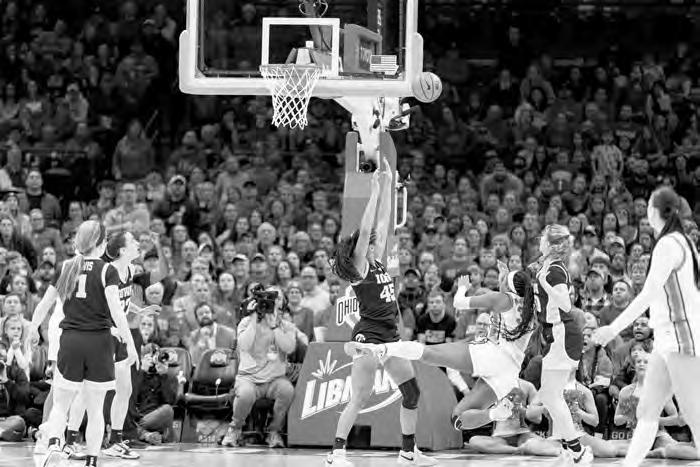
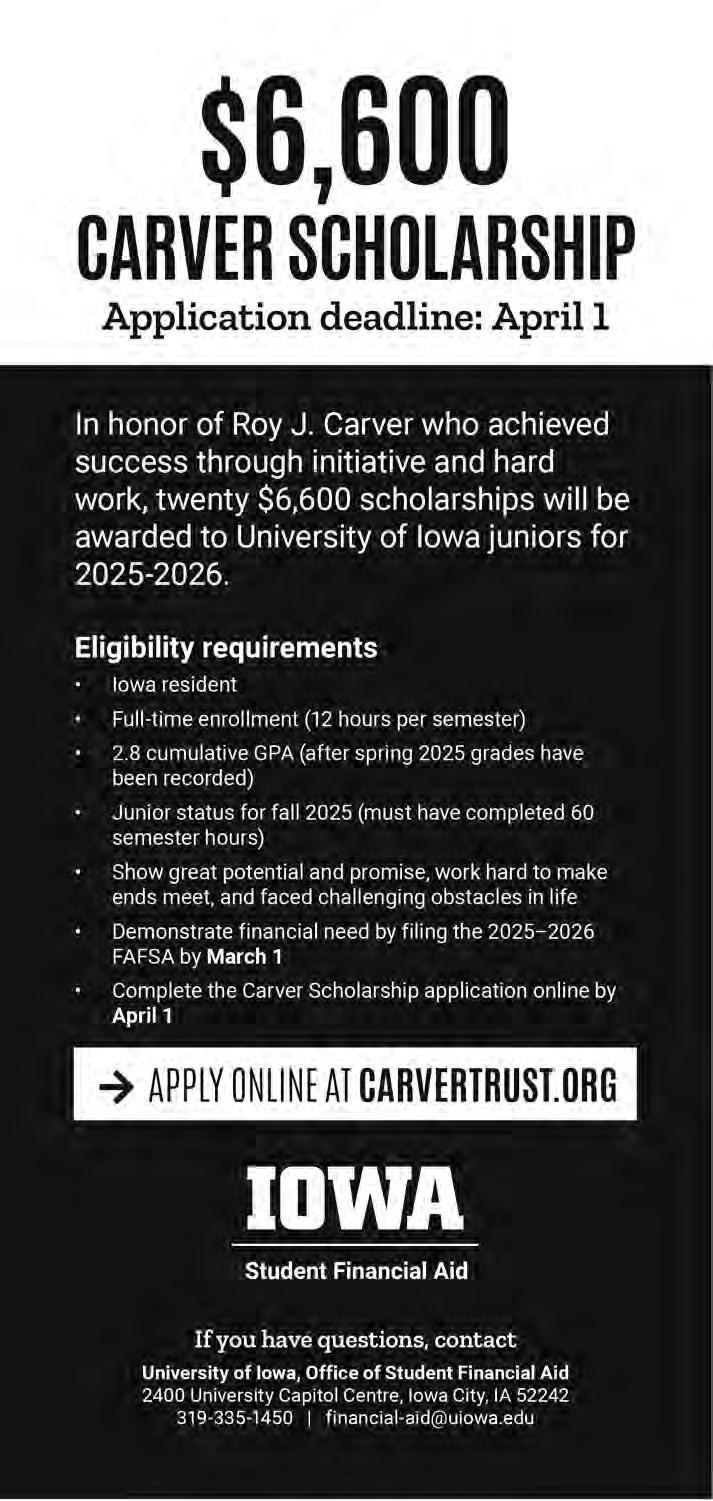
Prison-manufactured items sold across Iowa
Four years after two employees were killed at the Anamosa State Penitentiary, the role of prison labor across the state of Iowa is still being called to question.
Isobel Perez News Reporter news@dailyiowan.com
Tucked away five miles south of Newton, Iowa, Newton Correctional Facility holds 938 low- and medium-security inmates.
The facility is also the site of Homes for Iowa, a nonprofit organization that trains incarcerated individuals in home-building trades such as drywall, electric, plumbing, and framing to build affordable homes for Iowans and to reduce recidivism rates, the rate at which incarcerated individuals re-enter incarceration.
This program is in partnership with Iowa Prison Industries, which has manufactured supplies, like furniture previously sold to institutions such as the University of Iowa, University of Northern Iowa, and Iowa State University, according to the Iowa Prison Industries website.
This work is prior to an incident at the Anamosa State Penitentiary leading to the permanent closure of the Wood and Metal Furniture programs at both the Anamosa State Penitentiary and the Iowa State Penitentiary.
However, despite its prevalence in everyday life, most of the public doesn’t know many everyday items are sourced from prison labor. In fact, $2 billion worth of goods are produced by incarcerated workers.
Alongside receiving training for building the homes, the incarcerated individuals who work with Homes for Iowa typically work 10 hours a day, four days a week, building the foundation and framing of the houses and installing utilities and appliances within the homes.
Fridays are typically optional work days for the incarcerated workers depending on the number of orders Homes for Iowa receives with 21 homes sold for the next year, according to Chad Squires, a plant manager at Iowa Prison Industries and Homes for Iowa.
“Ultimately, we don’t want them to come back to prison,” Squires said. “Our goal is to keep our recidivism rate down as low as possible, and it’s been proven that our training programs work and give guys some opportunity to better themselves while they’re here.”
Incarcerated workers are also allowed to participate in apprenticeship programs and network at job fairs, which are offered twice a year with the hope of providing inmates with secured employment once they are released from prison.
“This gives [companies] the opportunity to come here and talk to the guys who are close to being released to give them a path from when they leave here to have the opportunity to work in one of those trades,” Squires said.
Squires described three “success stories”


of incarcerated workers who participated in Homes for Iowa and who had left prison: one who left with an electrical journeyman license and now works for Deaver Electric in Des Moines, another who now works for HVAC Mechanical in Des Moines who had previously worked in the HVAC Mechanical area with Homes for Iowa, and the third who now works for Habitat Humanity in Des Moines as a project manager.
While the programs provided by Iowa Prison Industries benefit incarcerated individuals through training, classes, apprenticeship programs, and job fairs, groups such as the American Civil Liberties Union have been calling for the abolition and reformation of prison systems and prison labor for years.
One of these reforms includes increasing the payments incarcerated individuals receive for the work they do while in prison.
Despite homes made by Homes for Iowa being sold for prices ranging from $83,000 to $99,000, inmates in Iowa prisons are typically paid between 28 to 95 cents per hour, according to a national report by the ACLU on prison labor in the U.S.
“This is exploitation of a literally captive audience,” Veronica Fowler, the communications director at ACLU Iowa, said. “Granted, it does cost the state money to incarcerate these people, but they’re being incarcerated against their will, and they’re also being charged for things like soap and phone calls, so it’s not like all their expenses are covered.”
According to ACLU’s report, at both the federal and state levels, incarcerated people
are often required to pay for their own basic necessities, such as food, medication, toiletries, phone calls, and co-pays for health care, with a study by Prison Policy Initiatives estimating incarcerated people in Illinois and Massachusetts spent an average of $1,000 per person at the commissary in one year.
Incarcerated people also deal with the impacts of inflation on the prices of commissary items, with prices of items such
gerous chemicals and machinery, lack of protective equipment, and poor training, which has led to serious injuries and death. The report also states 64 percent of incarcerated and formerly incarcerated people report concerns over safety while working. IPI’s operational updates describe its most recent safety incident as a chemical reaction at Anamosa State Penitentiary, which was successfully diluted and did not result in injuries.
However, an incident in March 2021, where two employees of Anamosa State Penitentiary were killed by two inmates attempting to escape the penitentiary, was more serious and led IPI’s Wood and Metal Furniture program to be closed indefinitely. As Squire explained, this is the reason why IPI stopped selling furniture to schools such as the UI. However, many schools, including the three regent universities, had previously purchased furniture, supplies, and moving and installation services from Iowa Prison Industries, with much of the furniture still filling students’ dorms and classes.
“[We’ve purchased] mostly just furniture,” Renee Funk, the chief procurement officer at the UI, said. “[IPI] helped us with some items during the pandemic that wouldn’t fall under the furniture category, like hand sanitizer, but it primarily is furniture that we historically have ordered from them.”
Funk explained the purchasing office at the UI is a facilitator of the purchasing process, not a decider of where items are purchased from, but that all items pro-
“Our goal is to keep our recidivism rate down as low as possible, and it’s been proven that our training programs work and give guys some opportunity to better themselves while they’re here.”
Chad Squires
Plant manager at Iowa Prison Industries and Homes for Iowa
as deodorant and toothpaste sometimes costing more to purchase at the prison commissary than at a local Walmart.
The wages earned by incarcerated people are also excluded from programs such as Social Security, Medicare, unemployment benefits, and Security Disability Insurance, which means the earnings incarcerated people receive while in prison do not contribute toward earning benefits provided by these programs.
“Iowa prisoners deserve to be paid a more fair wage for their labor,” Fowler said. “This simply isn’t fair, and it simply isn’t right.”
The ACLU report also describes the dangerous working conditions incarcerated workers face, including exposure to dan-
cured by the university are made publicly available through the e-bidding page. Even with purchasing made visible to the public, many remain unaware of the presence of prison-manufactured items in their everyday lives.
For Fowler and ACLU Iowa, by bringing awareness to the unjust nature of prison labor, which stems from slavery and a loophole in the 13th amendment, these practices can hopefully be reformed.
“We’re just trying to highlight [prison labor], make it more public knowledge, and speak out against it,” Fowler said. “[ACLU is] certainly on the lookout for any legislation and any specific instances that could potentially change the practice.”


JoCo’s fixer-upper grants aiding residents
Organizations including the Housing Trust Fund of Johnson County are coming together to continue supporting community members in need of assistance.
Madison Schuler News Reporter news@dailyiowan.com
Leaky faucets, broken air conditioners, drafty windows — one constant about owning a home is that eventually, something’s going to break. Many homeowners throughout the U.S. find themselves in desperate times when they cannot afford to fix a broken step or an outdated bathroom for a variety of reasons.
A 2023 study conducted by a research team at Today’s Homeowner found that of 1,000 homeowners in the U.S., 82 percent needed at least one home repair that year. The study also found 60 percent of homeowners pushed off the repairs due to unaffordability.
These findings hit home in Johnson County as well, and in recent years, as housing rehabilitation programs have begun offering support to homeowners in the community.
After noticing the need for home improvement aid, organizations began to team up to offer support. The organizations also aid residents who require assistance on necessary home improvement projects.
Some of those organizations include the Housing Trust Fund of Johnson County, the East Central Iowa Council of Governments, and the Iowa Valley Habitat for Humanity, with most collaborating on several housing rehabilitation programs throughout Johnson County.
In 2023, the East Central Iowa Council of Governments began offering the grant program after receiving $195,000 in American Rescue Plan Act funds, said Deanna Robinson, a planner and housing specialist at East Central Iowa Council of Governments.
The American Rescue Plan Act was first enacted in 2021 to supply governments with resources to respond to the impacts of the COVID-19 pandemic.
The funds allow governments to provide assistance to a variety of institutes, such as small businesses, nonprofits, and even households, while also improving infrastructures.
“The main objective was to help keep people in their homes by providing local homeowners assistance with home repairs and modifications that might allow them to age in place, improve their living conditions, and make the home more energy-efficient,” Robinson said.
Johnson County residents who meet the income requirements are allowed to apply for a grant in the form of a forgivable loan of $15,000 for a variety of restorations, including emergency repairs, exterior repairs, residential accessibility, roofing repairs, window replacements, and more.
In addition, households with older adults, those with chronic health conditions, and young children are considered top priority.
Robinson said the program has continued to gain more funding over the past few years, which has allowed for more grants and an increase in the dollar amount that could be spent on each home.
“[The program] is deeply impactful to

the homeowners that receive this grant because many times they have had a small repair problem that they didn’t have funds to address, and the problem became worse,” Robinson said.
of the Housing Trust Fund of Johnson County, said its programs have been funded by the Federal Home Loan Bank and the Housing Trust Fund for around 15 years.
“Many homeowners don’t have the capacity to work with contractors and to make sure that they have a good contract and the work is done properly. We manage the whole process from start to finish, so the homeowner doesn’t have to worry about any of those details .”
Deanna Robinson
Planner and housing specialist at East Central Iowa Council of Governments
Once residents are approved for the grant, the next steps in the process consist of housing inspectors traveling to residences and soliciting bids from registered contractors, Robinson explained. The best bid is chosen by the homeowner and the housing inspector, who continues to oversee the projects to completion.
“Many homeowners don’t have the capacity to work with contractors and to make sure that they have a good contract and the work is done properly,” Robinson said. “We manage the whole process from start to finish, so the homeowner doesn’t have to worry about any of those details.”
Ellen McCabe, the executive director
McCabe echoed the importance of the programs, which ultimately understand how crucial it is for individuals to stay in their homes.
“It would be very disruptive and traumatic for people to lose their homes because they’re not able to maintain them, and so this way, we can help provide support for people to make their homes safe and accessible,” McCabe said.
Over the years, McCabe said the mission behind the program has never wavered, but the cost of equipment and repairs have.
McCabe said there are around 12 to 16 open slots each year for recipients, so it
can be some time before people can get assistance. However, other emergency repair systems through the Iowa Valley Habitat for Humanity assist in those circumstances.
Scott Hawes, executive director of the Iowa Valley Habitat for Humanity, said since its establishment in 1992, the organization has built 135 homes in Johnson and Washington County. It also launched the Helping Hands program in 2018 to assist with home repairs and accessibility modifications.
“We focus on home ownership because we believe that it can be transformative,” Hawes said. “We also believe that affordable housing is an important way to improve health outcomes, and that isn’t just physical health, but it includes mental health and financial health and, of course, physical health as well.”
The organization has also expanded since its inception to cover five counties while aiming to build more houses, conduct more repairs, and increase sales at its ReStore home improvement stores and donation centers to keep items out of landfills.
Hawes said the organization also focuses on energy-efficiency projects, such as installing solar panels on homes.
“We’re always working to understand what the people need here in our community and looking to fill those needs,” Hawes said.
UI literary community stands up against book bans
With over 10,000 books banned across the country, Iowa City is pushing to protect intellectual freedom.
Genevieve DiChiara News Reporter news@dailyiowan.com
In recent years, the debate over book bans has intensified, sparking discussions about censorship, education, and the power of literature. Across the U.S. and beyond, schools and libraries have faced mounting pressure to remove books deemed controversial, often for addressing topics related to race, gender, sexuality, or historical injustices.
Over 10,000 books were banned across the country in the 2023-24 school year. The most, 4,600, were banned by Florida, and the second most, 3,671, were banned by Iowa.
One University of Iowa student is taking matters into his own hands after recent book bans escalated across the state.
Daniel Nunez, a fourth-year student at the UI, is starting a club called The Censored Library to encourage critical reading and discussions about book bans.
Nunez said this club will not be a regular book club where you discuss solely your opinions of the book but rather will rely on members to discuss why or why not the book should have been banned. The club will also discuss when the book was banned and in what state the ban took place.
“One of the main reasons I want to have a piece of the dialogue is because I don’t want it to be an echo chamber. It’s really easy to kind of get into the mindset of only agreeing with one opinion because that’s all you hear,”
To stoke conversation, Nunez said at random points he will play devil’s advocate to spark new thoughts in attendees’ minds so they can form their own arguments.
The first few books The Censored Library will read will deal with themes of censorship and restriction due to content and will move into books with strict or governmental issues — starting with “Fahrenheit 451.”
Nunez believes censorship of LGBTQ+ books is uncalled for, especially in children’s books.
“If a child has two moms or two dads, and every book is only mom and dad, they’re going to think, ‘Why don’t I have a mom and a dad?’ Reading a book can normalize it and help them feel more seen,” Nunez said. Nunez said books play a crucial role in shaping perspectives and fostering inclusivity, with an understanding that books are not the only way people can learn to understand each other.
While Nunez said technology is essential, especially from a generation that utilizes it so often, he believes it should not be everyone’s primary focus for developing inclusivity and perspective.
“I love technology, but as much as I love technology, I understand that a lot of the time it’s something for us to distract ourselves and not think about problems we’re facing,” Nunez said.

Nunez said with people coming from all over the world to attend the UI’s writing programs, which are embedded in one of the most literary cities, Iowa should be more open to books and new opinions.
“If any place shouldn’t be banning books, I feel like it’s here. It’s just kind of ironic,” Nunez said.
Benjamin Pape, a second-year UI student, is concerned by book bans. Being a screenwriting cinema major, Pape said he is against restrictions on arts in general.
“This is America. We were literally founded on freedom, and books are just another form of art,” Pape said. “Why do we get to censor something that comes from the heart?”
Pape said it’s unbelievable people want to take creative outlets away, especially from young minds.
“There has to be something sinister or nefarious going on here,” Pape said. “I don’t see why anybody would want to ban books, especially children’s books.”
At Prairie Lights, a local bookstore in downtown Iowa City, Tim Budd, an employee who designs the displays, has designated a shelf at the store particularly for banned books with articles decorating the area to educate patrons about the issue.
Budd said the shelf is heavily browsed, and people often leave with four to five books from it at a time. He added that many times, people come to the shelf not realizing some of these books have been banned and want to read them to understand why.
“I’m surprised at how much attention it’s gotten,” Budd said. Jan Weissmiller, owner of Prairie Lights, has even given large quantities of banned books to organizations who want to distribute them and provided discounts on the books they purchase.
“We’re just in a really bad time, and Iowa’s not [helping],” Weissmiller said.
IC sees the downfall of Sycamore Mall
Joann’s Fabric is the latest among several retail shops that have had to close their doors in the Iowa City Market Place, which was formerly known as the Sycamore Mall in Iowa City.
Isobel Perez News Reporter news@dailyiowan.com
Large red signs outside Joann Fabric and Crafts in Iowa City loom over its windows, advertising 20 to 40 percent sales across all items in the store — something any crafter in Iowa would typically be overjoyed to see. But the signs signal the most recent change to the Iowa City Marketplace: the closure of Joann’s location on Sycamore Street.
The shuddering of Joann’s follows the craft store’s filing for Chapter 11 bankruptcy for the second time in the past year. While the company was originally set to close only 500 of its 800 locations, the liquidation firm, GA Group, who now own Joann’s, decided to close all locations.
However, Iowa City Marketplace, formerly known as the Sycamore Mall, is no stranger to store closures and has had many retail locations come and go over the years, changing the aesthetics and dynamics — and profitability — within the mall.
The Sycamore Mall seen today is bisected and boarded up so the path to the end of the mall runs outside in front of University of Iowa QuickCare, H&R Block, Ollie’s Discount Store, Marcus Theater, and Tru Blends Grooming Lounge.
The inside of the mall is empty and dimly lit, a ghostly echo filling the wide hallways. There’s no one inside except for a few customers who can be heard chatting inside stores. Signs line the windows of businesses, welcoming custom-
ers inside and hanging as though patiently waiting for more people to arrive.
The Hallmark sign still hangs over one of the entrances to the mall that hasn’t been boarded up, but this store hasn’t been in the mall for years, so it only advertises a vacancy waiting to be filled.
The decision to close Joann’s locations broke the hearts of many in the crafting community, including those in the University of Iowa Knitting Club, who gather weekly to destress from classes and find community through crafting. Members of the group often go together to Joann’s on weekends to buy inexpensive supplies like yarn, needles, and hooks.
“I heard that they were all closing, and I texted one of my friends immediately, and we both started losing our minds,” Emery Otte, a fourth-year student at the UI and a member of the knitting club, said. “I want to cry about it, but I shouldn’t cry about yarn.”
Julie Brashers-Krug, a fourth year at the UI who has lived in Iowa City since she was six and previously worked at Joann’s, said the one constant thing about the Sycamore Mall is it was always changing, describing the mini golf at Par-Tee Zone that was eventually replaced by the workout equipment at Planet Fitness.
“I remember a lot of things changing, especially a lot of things shutting down,” Brashers-Krug said. “There was a sign up in the window after that place closed down that said ‘New yogurt shop, coming soon.’ It did not come soon. It never arrived.”
Part of this change comes
from the mall constantly rotating through anchor stores — large, well-known retail stores that draw in consumers, often to the benefit of smaller stores within the mall.
In 2013, Von Maur, which had been housed in the Sycamore Mall and an anchor store for the location, moved to the Iowa River Landing in Coralville. With this relocation of Von Maur also came the rebranding of Sycamore Mall to Iowa City Marketplace.
The space left open by Von Maur was eventually filled by Lucky’s Market in 2015, which ultimately closed in 2019, leaving the mall, once again, without an anchor store.
The state of the mall remained uncertain until, in 2022, Iowa City Marketplace was sold to Brookwood Capital Advisors, a Tennessee-based retail and development company, for more than $14 million. One of the spaces the company leased out was the space left open by Lucky’s Market, which, in 2023, was filled by Ollie’s Bargain Outlet store, marking Ollie’s first location in Iowa.
While the spot left open by Von Maur and Lucky’s Market has finally been filled, the new space left open by Joann’s closing has also left Anika Jain, the president of the UI Knitting Club, wondering how this will further impact the Iowa City Marketplace. She said she wonders how it will specifically impact those in the crafting community who relied on Joann’s as a source for not only supplies but community and classes, too.
“There’s nothing quite the same as going in person and picking out colors or picking out fabrics, or

my friends and I would just go and look around,” Jain said. “Joann has classes that just can’t happen as well online, so it really helps create a generation of crafters, and it’s really sad to see those opportunities going away.”
Chloe Ladines, a third-year student at the UI and the treasurer of UI’s Knitting Club, also mourned not only the loss of Joann’s but the loss of mall culture overall — especially for children who no longer have the spaces provided by malls to play indoors or safely gather.
“Where are we supposed to congregate now?” Ladines said. “I don’t know. But [the mall] brings the family together and brings friends together.”
For Brasher-Krug, however, the decaying state of the mall isn’t a significant loss to the Iowa City community because Iowa City still has its bustling downtown scene.
“I much prefer downtown culture in general [because] mall culture, to me, is someplace you have to drive to, it’s someplace isolated,” Brasher-Krug said. “It’s nice to have a place to shop as people in a smaller city, and this is our only in-town mall. So, it’s a shame it’s in such bad shape. But, in general, I don’t think Iowa City has really felt its loss very hard.”
And maybe Brasher-Krug is right, considering when asked how they felt about the state of the Sycamore Mall, neither Otte nor Ladines knew where the mall was located.
But despite the death of mall culture in the U.S., shops in the Iowa City Marketplace like Tru Blends are still finding ways to draw in business and sustain themselves.
As a barber shop, Tru Blends does not rely solely on the foot traffic drawn in by the mall and instead builds its own network outside of the mall through its website, social media, and wordof-mouth.
Even with its continued success, Jakari Smith, a barber apprentice at Tru Blends, still believes physical spaces like malls and barber shops are important.
“People need that physical space,” Smith said. “You come in here, you see a physical space where you have barbers at, and you see the atmosphere. [People] are hanging out, there’s music going, might be sports on TV or music on TV, so it’s important for that aspect.”
As for the future of the Sycamore Mall itself, Peggy Stover, associate professor and director of the Marketing Institute at the UI, said she believes mall culture will not see a resurgence in the U.S. and that empty spaces within the mall should be repurposed.
Stover explained how these spaces could be converted into services a community may need, such as health clinics, public libraries, or office spaces, and some malls have already begun such conversions. This can be seen in the QuickCare Clinic that opened in the Iowa City Marketplace.
“The footprints of the building itself, it needs to find a new purpose because if it sits there vacant, what ends up happening is it starts looking like an eyesore to the community,” Stover said. “Finding a new use for the real estate itself is going to be a critical component that these communities need to face, and the owner of the building itself.”
‘Bitchin’ Events’ offers opportunities to meet friends
IC resident Tiara Phillips started planning events
Chloe Oppelt News Reporter news@dailyiowan.com
Iowa City’s downtown district is home to many businesses and places to gather for college students and locals alike.
Bitchin’ Events, a small business launched earlier this year, is bringing a whole new array of events to downtown. From book clubs to craft sessions, Bitchin’ Events offers a variety of fun opportunities to the Iowa City community.
The woman behind Bitchin’ Events is Tiara Phillips, an Iowa City native and University of Iowa alum. She had the idea for Bitchin’ Events in her head while working as part of a trio running a small crochet business called Bitchin’ Stitchin.’ She decided to pursue Bitchin’ Events on top of the crochet business. Phillips officially launched in January 2025.
“We would sell our crochet at markets, but they were super expensive to be a part of. I thought ‘I should just run it myself.’ If I ran it, I could attend it for free,’” she said.
The Green House Bar has been able to provide space for Bitchin’ Events to host events at no extra charge to Phillips. Her first event was held in February in the spirit of Valentine’s Day.
“I decided to do a singles mixer, and it was incredible … About 70 people showed up,” Phillips said. “People have asked me how I know I’ll be successful in this [event planning], and I say I’ve already done it.”
The singles mixer had a lot of elements to it. Blaine Sager attended the event in February and has attended some Bitchin’ events since then.
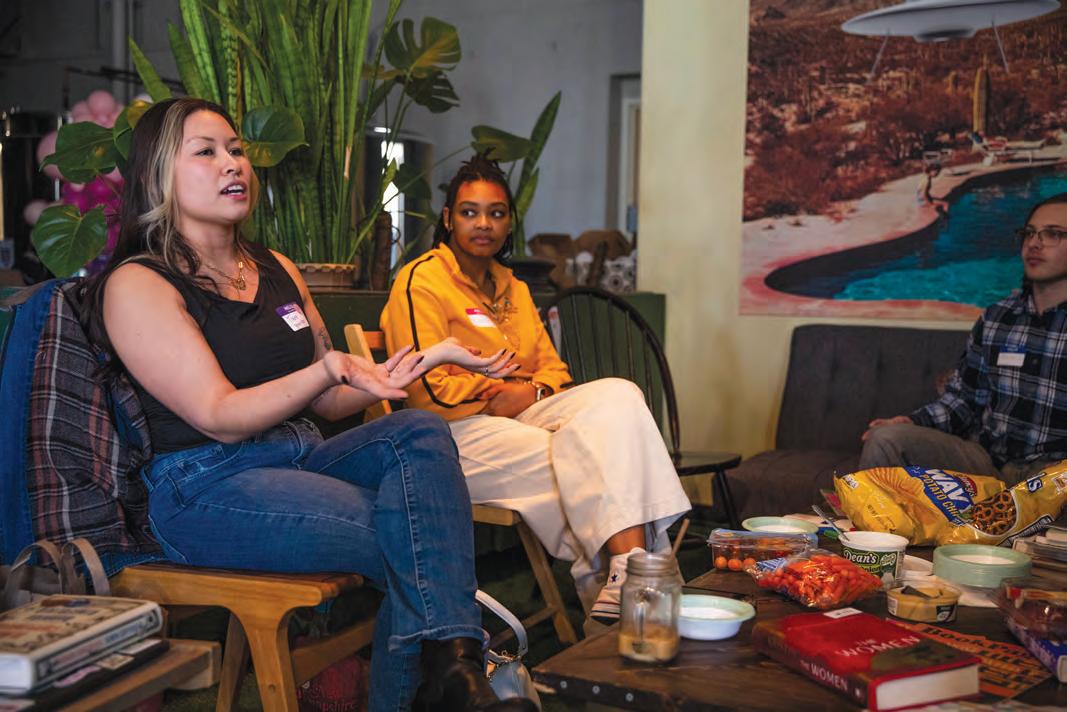
believe anyone would care,” she said.
“It can be really scary and daunting going into a situation like that, but it was fun. It was easy, comfortable, and organized very well. Tiara had great ideas … There was bingo and prizes,” Sager said. Phillips was shocked by the turnout at the first event. She started her business with the idea in mind that not many people would attend, but it would give those who wanted a chance to meet new people.
“Nobody knows what to do anymore. No one knows how to meet anyone anymore. It’s so hard after COVID. Once you leave college, you’re down to another place where you have the chance to meet people. After a certain age, it gets harder to make friends, so I am really grateful to the community for showing up. I can’t
In her day-to-day life, Phillips works at the UI as a full-time purchasing agent. On top of her full-time job, crochet business, and event planning company, Phillips is a busy woman. That’s not all she does, though. She also caters and petsits when she’s not doing other tasks.
Phillip’s number one supporter is her partner, Colin Underwood. He regularly attends the events Phillips hosts.
“It’s great. She has really great ideas. She came up with this plant bingo game thing,” he said. Bitchin’ Events was launched for many reasons, but overall to bring people together. Phillips said she values community and believes in strengthening it. “I think there’s a lack of leadership when it comes to events,” she said. “It’s very difficult to do these kinds of things. There’s a lot of artists that are great at what they do creatively, but it can be hard to plan and execute things.”
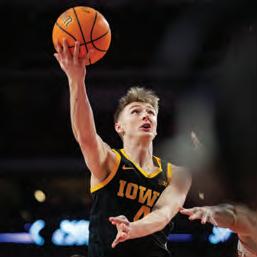
Words fueling team success
The No. 2 Iowa men’s wrestling team lives by slogans moving through the postseason.

Iowa’s 174-pound Patrick Kennedy grapples the leg of Iowa State’s Aiden Riggins during a Cy-Hawk men’s wrestling dual between No. 2 Iowa and No. 12 Iowa State at Carver-Hawkeye Arena in Iowa City on Nov. 23, 2024. The Hawkeyes defeated the Cyclones, 21-15.
Trey Benson Sports Reporter sports@dailyiowan.com
Walking through the bright halls of the Goschke Family Wrestling Training Center, streaks of black marker on Tom Brands’ white and gold shoes catch the eye.
“Kata Ashi,” he announced, his voice echoing through the halls. “Japanese for leg attack. Kata Ashi.”
Brands is the type of coach who gets involved with the team, known for continuously grappling with his wrestlers during
practice and training. Even at 56 years old, he imparts his knowledge on those around him, exemplified by the Japanese slogan across his shoes for all to see — a motto he lives by.
It’s a constant reminder simplifying the complex sports of men’s wrestling.
“It’s about sports psychology,” Brands said.
“It’s about being at your best, and it’s about peaking. Peaking is a mindset. This time of year, you want to be at your best. It’s important that you’re at your best.”
Even the strongest mental competitors can crack under pressure. That’s especially true when there are 14,998 avid wrestling
fanatics all with eyes glued on the infamous Tigerhawk in the center of a sold-out Carver-Hawkeye Arena, cheering for a Hawkeye victory.
Whether Iowa is wrestling at home or at Penn State’s testing Bryce-Jordan Center, this simple mantra from Brands gives athletes something to fall back on during intense matches — a simpler headspace.
“And in order to be your best, you don’t just start that ‘self talk’ and sports psychology now,” Brands said. “As you get to the higher levels, [sports psychology] gets more and more important. And it has to be a part of your game.”
Hawkeyes finish 2024-25 season with an undefeated duals record
Three Hawkeyes won individual national titles, while
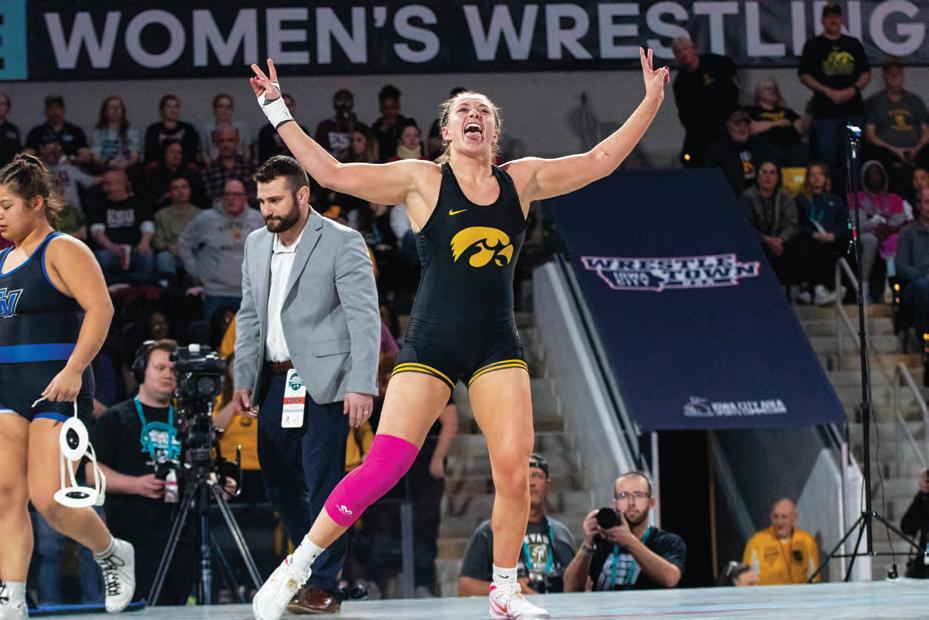
Jackson Miller Sports Reporter sports@dailyiowan.com
Iowa Hawkeyes women’s wrestling finished its second season as a program as back-to-back national champions. The Hawkeyes claimed three individual titles, while all 15 wrestlers who competed earned All-American honors. The Hawkeyes finished undefeated in duals on the season, winning the National Duals title in January. Iowa also posted large success in multiple open tournaments throughout the season. Head coach Clarissa Chun said she is extremely proud of how her wrestlers fought throughout not only the national championships but the entire season.
“Our women fight hard,” Chun said after the national championship victory. “They deal with a lot of pressures from themselves to represent Iowa. They do a great job
being able to manage such rigorous, hard academic schedules alongside the training schedule. They’re amazing. They really do love each other so much. We lift each other up and push each other forward. I’m so grateful for this team.”
The Hawkeye women’s wrestlers began the season in Indianola on Nov. 2, 2024, where they brought home six individual champions at the Luther Hill Open. In that tournament, the Hawkeyes advanced 14 wrestlers to the semifinals and 10 to the championship finals round. Their immediate success would only continue throughout the remainder of the season.
Iowa cleared through ranked opponents throughout the year such as No. 8 Wartburg, No. 7 Lindenwood, No. 6 Presbyterian, No. 4 McKendree, and No. 2 North Central, to name a few. The Hawkeyes were ranked second to King
In a day and age where technology brings negative press from media and fans are at the disposal of each wrestler’s fingertips, sports psychology is more prevalent than ever. Brands understands this and is constantly reminding his athletes about the importance of having a strong mindset on the mat.
“Self-talk is important,” Brands said. “Definitive statements about yourself that are positive, controlling the crazy and the negative that are input, being able to take a
Finding real appreciation amid adversity
Payton Sandfort’s final season has not been ideal, but it was a microchosm of his character.
Matt McGowan Sports Reporter sports@dailyiowan.com
It’s just a game.
Payton Sandfort tells himself these words. Or at least, he tries to. His father and grandfather repeat the mantra whenever they can, but sometimes the message reverberates like a dribble on a barren court amid an empty arena — hollow. The sound travels, but no one’s around to hear it.
Playing before thousands of fans at Carver-Hawkeye Arena and across the Midwest, Sandfort’s worldview shrinks to new dimensions. What happens inside the 94 by 50-foot hardwood rectangle dictates his emotions. The numbers on the Jumbotron overhead reflect his facial expressions.
But it’s not a matter of life and death. At least, that’s what he tells himself. He’s a 22-year-old kid from Waukee, Iowa, living out a dream.
Social media has a different message.
“A lot of people quitting on us,” Sandfort said ahead of Iowa’s latest matchup against Michigan State. “I got death threats. I’ve got all sorts of stuff this season, but I never quit.” Sandfort had the opportunity to turn professional at the end of last season but bypassed a potential NBA future to return to his home state and guide the team he grew up watching back to the NCAA tournament.
But those aspirations haven’t materialized yet. The 16-15 Hawkeyes need to win the Big Ten tournament to punch their ticket to the Big Dance. Prospective teams will glance at Sandfort’s numbers and notice declines in points per game and shooting percentages from the floor, three-point range, and the charity stripe. Team failure is compounded by personal struggles, all the while trying to play hurt. That’s the reality of Sandfort’s final season in the Black and Gold, and the pressure to alter that reality became a burden.
“I can’t imagine there’s that many people who hate to lose more than I do,” Sandfort said. “I pretty much beat myself up from the minute it ends until the next game starts … I think my pursuit of being as good as I can has paralyzed me at times, and it’s affected my play.”
UPCOMING
Men’s Basketball
Wednesday, March 12
Big Ten Tournament
Indianapolis, Indiana TBD
Softball
Wednesday, March 12
St. Thomas Iowa City, Iowa
3 p.m. and 5 p.m.
Saturday and Sunday, March 15-16
Indiana Bloomington, Indiana
Baseball
Friday through Sunday, March 14-16
Swimming and Diving
Wednesday, March 12
NCAA Zone Diving
Championships
Iowa City, Iowa
12 p.m.
Track and Field
Friday and Saturday, March 14-15
NCAA Indoor
Championships
Virginia Beach, Virginia
Women’s Tennis
Friday, March 14
Illinois
Champaign, Illinois
5 p.m.
Gymnastics
Sunday, March 16
Minnesota Quad
Minneapolis, Minnesota
2 p.m.
WHAT YOU’VE MISSED
Emily Erb flying high for Iowa
The third-year is having a monumental season with the Hawkeye gymnastic squad.
Jack Birmingham Sports Reporter sports@dailyiowan.com
Thanks to the efforts of returner Emily Erb, Iowa women’s gymnastics has gotten a big boost this season. The third-year has had a momentous season for the Hawkeyes, tying a scoring record for floor in a home meet against Illinois on Feb. 16.
Erb was one of five athletes competing in the exercise for Iowa against the Fighting Illini, and the pressure was building as the New Jersey native took the floor.
Michigan State Iowa City, Iowa Jackson Miller Sports Reporter sports@dailyiowan.com
Former Wake Forest offensive coordinator Warren Ruggiero has been named a senior offensive analyst for the Iowa football team, per a report from 247Sports on March 3. Ruggiero’s career with the Demon Deacons saw new highs in points scored and total yards during the 2017 season. From 2014-24, Ruggiero’s offense broke over 100 individual and team records. The 2021 squad ranked fourth in the nation in total offense, winning 11 games in the process. Ruggiero’s start with the Hawkeyes comes after a rather disheartening 2024 season that saw Iowa grab an 8-5 overall record, including 6-3 in the Big Ten. The Hawkeyes also dropped the TransPerfect Music City Bowl to No. 19 Missouri, 27-24.
A Delaware alum, Ruggiero coached multiple professional players, among them NFL quarterbacks John Wolford and Sam Hartman. His time at Hofstra saw him recruit and coach future Saints’ quarterback Marques Colston, while his lone season at Kansas State saw him coach Josh Freeman, a future first-round pick for the Tampa Bay Buccaneers. In 2021, Ruggiero was a finalist for the Broyles Award, which is given to the top assistant coach in college football and was previously won by Iowa’s Phil Parker in 2023. Wake Forest was the latest credential in a long line of schools that also included Bowling Green and Elon, the latter of which Ruggiero broke many school records for.
QUOTE OF THE WEEK
“Anything happens in March. You [have to] be ready, and if you’re not ready, then you don’t get to have as much fun. I do think we’ll be ready.”
Nevertheless, Erb nabbed a perfect 10.000 and a 9.950 to score a 9.975, tying a program record that has not been matched since 2022.
“Every single person went and completed their best routine,”
Erb said. “We had a few other girls in the lineup go their career high, which is super exciting. I knew that there was a little added pressure just because we were counting up all five routines, but I had confidence in myself and in the team. I just went out there, followed my cues, trusted my training, and just had fun. The energy in the arena was great.”
Erb also praised her performance as part of a larger effort that owed to a good team rapport.
“Our team chemistry is so good this year,” Erb said. “We have a lot of trust in every single person who steps up, no matter what event. This year, we are doing a lot. We’re having a lot more fun on the competition floor and in practice. The energy has been really great.”
Despite Illinois being ranked at No. 26, the underdog Hawkeyes kept their composure and pulled off the upset, besting the Illini, 196.200-194.975.
“I think her career high was such a great moment, not only for her, but for the whole team,” third-year Kaia Vanney said.
Q&A | HANNAH LINDSAY
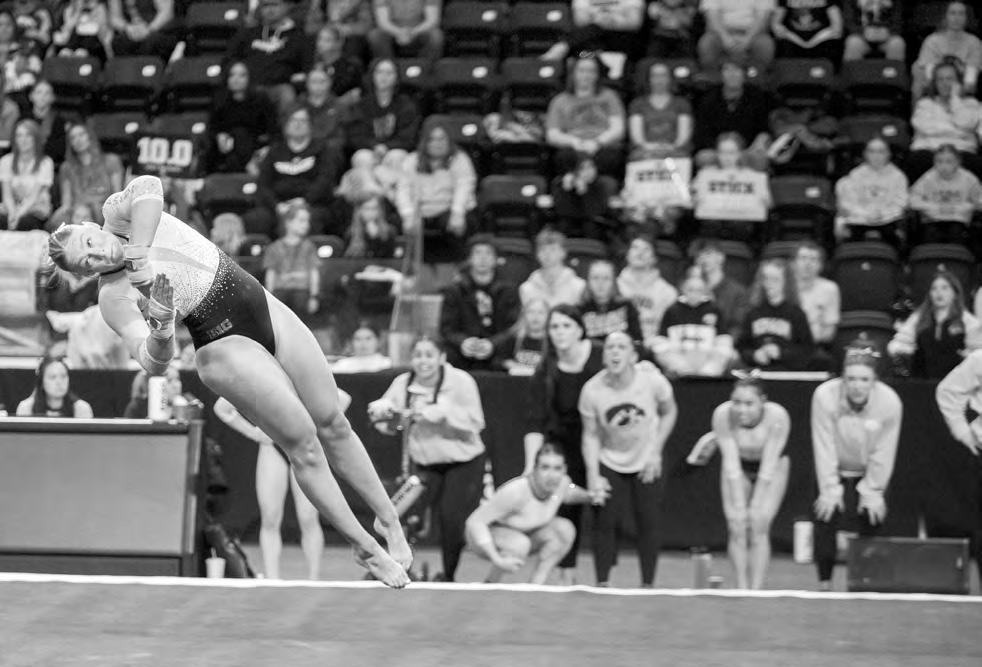
Vanney also noted Erb’s high score as a satisfying conclusion to a challenging competition.
“I think the moment was so special because the whole meet was filled with adversity,” Vanney said. “For it to end on such a high moment and for it to be Emily was even more special. Her hard work paid off.”
Iowa kept chugging along following the team’s victory over Illinois, later placing second with a score of 196.125 at the Big Four Meet on March 2. Iowa was just short of No. 7 Michigan State and
“She is so confident on the floor and she has got her mentality and her rhythm down, which is something that we’ve been really working on as a team.”
Kaia
Vanney
Third-year Iowa gymnast
ahead of Washington and No. 25 Penn State. Erb contributed a 9.900 on the floor routine, just short of her
Iowa catcher talks favorite classes, music
The Daily Iowan: What is the toughest aspect of softball for you?
Hannah Lindsay: The toughest aspect would be managing the student-athlete life — staying on top of school and also being away from home. I’m from Arizona, and I think being this far from my family and my sister has been the toughest part.
What is your favorite class you have taken at the University of Iowa, and why is it your favorite?
Either Nutrition or Promoting Health Globally just because I am a health studies major. I think those classes definitely relate to me as a student athlete and my career path goals.
POINT | COUNTERPOINT
Who
impressive Illinois performance.
“I think what’s really admirable about Emily is that she comes into the gym every day,” firstyear head coach Jen Llewellyn said. “She’s very diligent about how she goes about her practice and her preparation. What you see on the competition floor is really what she practices every day.”
Llewellyn also expressed admiration for Erb’s mentality.
“She does everything the right way,” Llewellyn said.
“She takes care of herself mentally, physically, and she really cares about trying every single meet to get a little bit better on floor. It’s awesome to have an athlete like that.”

Who is your softball idol and why? Growing up, it was always Paige Halstead. She played for UCLA, and when I got to college, I actually got to work with her for catching stuff back home in Arizona. She’s got a baseball swing, and has always been a really hard-worker.
When did you know you wanted to play catcher? Before I started catching, I was a first baseman and third baseman. I chose catching because you’re in the game every pitch, and it’s a crucial point of the game. You are constantly thinking ahead, managing the rest of your defense, and I just enjoy being involved in every pitch.
What is your favorite part about playing for Iowa?
I have dreamed of playing for a Power Five school my whole life and being able to get the opportunity to step on that field and just taking in all the fans and the young girls that I get to talk to after the games.
What was the toughest part about transferring, and how did you overcome that?
The toughest part of transferring for me was that I didn’t know where I would end up or where I was going to live. That was definitely the most stressful part, just not knowing what my next steps were. I also think, once you get here, it’s like freshman year all over again and trying to figure out the team dynamic. It’s been a really good experience for me, but it was challenging my junior year, being the only transfer [on the team] at the time.
should head Iowa men’s basketball?

Darian DeVries
Bring the DeVries family back to Iowa.
Darian DeVries has been mentioned as a possible successor to Iowa men’s basketball’s Fran McCaffery for some time now, despite him being an active coach. He currently coaches at West Virginia, where his son, Tucker plays.
sixth 20-win season in program history. To make matters more impressive, Darian led the team with the second-fewest returning letter winners in the nation that year.

- Iowa women’s basketball head coach Jan Jensen
STAT OF THE WEEK
2,000
Fourth-year Iowa women’s basketball guard Lucy Olsen eclipsed the elusive career scoring mark during the Hawkeyes’ first round Big Ten tournament victory over Wisconsin.
Darian was born and raised in Aplington, Iowa, where he became a prominent player in the area while playing at Aplington-Parkersburg High School in the mid-1990s. He then continued his playing career at Northern Iowa, followed by a graduate manager position with Creighton’s men’s basketball program, a Nebraska-based school.
He worked his way up to an assistant coaching position in 2001 after three seasons in his hired role. And after 17 years with the program, Darian accepted his first head coaching gig with Drake men’s basketball in March 2018, allowing him to return to his beloved home state.
In his first season there, the Drake Bulldogs recorded their
Darian held six more success ful seasons with the Bulldogs — including being named a twotime Mountain Valley Conference Coach of the Year and the program’s first NCAA tournament bid in 50 years — before being hired by the Mountaineers in March 2024. Calls for McCaffery’s exit have been gaining steam in recent weeks, and for good reason. The roster can be competitive in the Big Ten, though it’s been a big disappointment as the team possesses a 15-14 overall record and a 6-12 conference record, all while owning statistically the worst defense of all 18 Big Ten teams. And while he’s only been at West Virginia for one season thus far, a return to Iowa can’t be overlooked. The Hawkeyes have a solid core to build with: Josh Dix, Owen Freeman, Brock Harding, Seydou Traore, Cooper Koch, among others. Not to mention four-star prospect Joshua Lewis coming in next year. Darian’s older brother, Jared, is a former University of Iowa All-American defensive end, adding a personal attachment to the university. Now, it’s Darian DeVries’ time to join the Black and Gold.
Fran McCaffery
This has happened before. Consecutive seasons without an NCAA tournament berth. A 19-win campaign followed by one that hovers around .500. A restless fan base demands a coaching change.
After the 2017-18 season, Iowa men’s basketball head coach Fran McCaffery was cast in doubt. His Hawkeyes won just four Big Ten games, a paltry number not seen since McCaffery’s first year at the helm and the dreaded days with Todd Lickliter in charge. This year’s Iowa team is marginally better record-wise but has eerie similarities. Blowout losses on the road balanced by heartbreakers at home, creating a conundrum in evaluating how good the Hawkeyes really were. The 2017-18 squad featured up-and-coming underclassmen such as Tyler Cook, Luka Garza, Jordan Bohannon, and Connor McCaffery.
This year’s team features potential in Brock Harding, Owen Freeman, and Seydou
Traore, but the serious hype surrounds incoming four-star recruit Joshua Lewis.
Lewis, joined by three-stars Badara Diakite and Dezmon Briscoe, form one of Fran McCaffery’s better recruiting classes. A coach who’s on his way out the door wouldn’t have stockpiled such talent. Fran McCaffery said he has no intention of moving on, and while athletic director Beth Goetz can change that reality, it would be wise to consider the repercussions.
Decommitments, transfers, a hodge-podge of newcomers under a fresh head coach. Success won’t be immediate once Fran McCaffery leaves. The head coach’s best days could still be waiting. Following that ugly 2017-18 season, the team qualified for four of the next five NCAA tournaments, advancing to the second round twice. A Sweet 16 appearance remains to be seen, and its absence is a glaring point of criticism of Fran McCaffery, but a trip to the second weekend of the NCAA tournament isn’t hopeless. A new head coach could still accomplish the feat, but it would entail a lot more roadblocks to get there. As Michigan State’s Tom Izzo put it, Fran McCaffery is “one of the good guys.” Let him leave on his own terms.
deep breath, make it positive, and talk to yourself positively nothing else matters for what you control.”
Brands’ continuous focus on positive self-talk and motivation has been an instrumental part in Iowa’s offensive dominance on the mat. The constant barking from both him and his brother, assistant coach Terry Brands, in the corner serves as a simple reminder to Hawkeye wrestlers: A strong mental game alongside a simple single-leg takedown can ultimately be the deciding factor between Iowa’s successes and failures on the mat.
As the No. 2 team in the nation, Tom Brands’ method to his madness has proven to be successful for Iowa. Brands has accumulated three NWCA Coach of the Year awards to match four NCAA championships, six Big Ten team titles, and 104 All-Americans.
With almost 19 seasons manning the helm for the Hawkeyes, it is more than apparent that Brands has continued the excellence and longevity of Iowa wrestling, even as he pushes against a dominant Penn State dynasty.
For over a century — 114 years, to be exact — there is no question the Iowa men’s wrestling program has established its superiority across the sport. While most collegiate programs opt to keep their respective secret formulas to success close to their chests, Iowa wrestling isn’t afraid to divulge a slogan or two in turn.
One approach in which Hawkeye wrestlers have been very vocal about this season has been, “Exhaust the scoreboard.”
The phrase was first crafted by tenured Big Ten play-byplay announcer Shane Sparks, a reference to the constant search for points in any which way on the mat. A quick search on X, formerly known as Twitter, shows Sparks’ profile littered with the hashtag #ExhaustTheScoreboard.
While Sparks’ tweet there was highlighting Penn State wrestler Mitchell Messenbrink, Hawkeye wrestlers have taken a liking to the mantra this season. From 174-pounder Patrick Kennedy to 184-pounder Gabe Arnold, Hawkeye wrestlers have internalized those words.
“Put your work boots on, and shut up and go to work,” Kennedy said. “You just go out there, wrestle how you want to wrestle. Put the scoreboard in a position of exhaustion. I love to put points on the board. [To quote] the great Shane Sparks, ‘exhaust the scoreboard.’”
Kennedy, moments after a dominant 19-4 technical fall win over Iowa State Cyclone Aiden Riggins, attributed his win to his mindset of exhausting the scoreboard.
The U23 National Champion from Kasson-Mantorville, Minnesota, once again reiterated the motto during media availability following Iowa’s 21-15 victory over the Cyclones.
University in the preseason poll but quickly flipped the script to take over the top spot with early-season domination that continued all year.
“I think it was just their competitive advantages,” Chun

“I just want my wrestling to look like a guy who’s out there who’s free-flowing and really chasing the points,” Kennedy said. “You want to see the scoreboard exhausted and tired … You just get your freaking hand raised.”
Kennedy is not the only Hawkeye grappler using this battle cry to his advantage. Teammate Gabe Arnold has also been heard using the phrase from Sparks.
“I just like to put up points,” Arnold said after Iowa’s dual meet with Wisconsin in January. “If a pin is there, I’ll take it. If not, then I’ll resort to my bread and butter — putting it on guys, finding the tags, finding ways to win matches, and as Shane Sparks would say, ‘exhausting the scoreboard.’”
The scoreboard was certainly drained on one side, as Arnold had defeated Wisconsin Badger Dylan Russo in just 1:27 with a pin, adding six points to Iowa’s team total. Arnold’s
said regarding her team’s success to at the NCWWC press conference last Thursday. “Just reminding them what they bring, what is their competitive advantages to continue to bring out their best. This is what we train all season for, just to go out there and have fun and do what they do.”
Heading into nationals, the Hawkeyes held at least one top-10 ranked wrestler in each weight class with six ranked

SANDFORT from 1B
pin was a driving force behind Iowa’s commanding 45-0 win over Wisconsin. Sometimes a drive to exhaust the scoreboard opens the path to better maneuvers.
At 14-1 this season, Iowa wrestling’s only loss on the year comes from top-ranked foe Penn State, who has held the No. 1 ranking all season. The Hawkeyes were stunned in their first attempt against the Nittany Lions, dropping the dual, 30-8, in a disappointing performance.
In pursuit of the Nittany Lions once more this postseason — and likely in the wrestling world moving forward — it’s imperative the Hawkeyes stick to the their foundations. While scouting for Penn State will surely involve a very detailed and complex strategy, two mantras of Iowa’s master plan have remained true no matter the opponent — “exhausting the scoreboard’ and “kata-ashi.”
number one in the country. Perhaps the most impressive group for the Hawkeyes this season was the newcomers. Top-ranked Hawkeye transfers at 145 and 160 pounds Macey Kilty and Kennedy Blades each claimed individual national titles at their respective weight classes. Kilty had not competed in a team setting since high school and had just one year of eligibility coming into this season. Blades finished her first season as a Hawkeye with a 25-0 record, winning each match by technical fall or pin.
“I think it’s a blessing in disguise that I got to have this one opportunity this year to participate in something like this,” Kilty said at Thursday’s press conference. “It is only growing, and it’s only going to get cooler for other girls coming up. We break down everything with ‘for her,’ because it really is for her, the next generation. I didn’t have an opportunity like this coming out of high school, so it’s kind of like a backwards track for me, but I’m glad I get this opportunity and these girls will have an opportunity after me to do something bigger.”
Just as impactful were the first-year wrestlers who stepped into the lineup and dominated all season. Rianne Murphy and Naomi Simon each placed third in their respective weight classes at 103 and 180 pounds. Murphy finished the season with a 32-4 record while Simon finished 39-4, three of her four losses being against teammate Kylie Welker, who also claimed her second straight individual title Saturday. Each of Simon’s victories came by tech fall or pin.
“It’s great,” Chun said about the first-year and transfer wrestlers at last Thursday’s press conference. “I think their immediate impact doesn’t come without the support of the upperclassmen. The upperclassmen came in three years ago, and they didn’t have anyone showing them the way. We were all new to Iowa, we were all new to campus, we were all new to the inner workings of being a D1 athlete. It was so great to see the freshmen getting to have that opportunity to have their arms wrapped around and shown the way by our upperclassmen.”

WE’VE MOVED!
119 ½ E . W ash in gton S t., Iow a Cit y (next to Target)
we’re in right now,” Sandfort said. “It feels like there’s a black cloud hanging over you.”


Following Iowa’s loss to Utah in the second round of the NIT last season, Sandfort and Iowa head coach Fran McCaffery attended the NBA Combine. Pre-draft workouts and negotiations on a two-way contract between an NBA team and its G League affiliate gave the forward a tangible preview of a post-college career. But Sandfort wasn’t at 100 percent health that summer, dealing with injuries that disrupted the rhythm of his offseason.
319 .3 39.TAT2 (8282) hotspo a o o.com
Heal th D e pa r tm ent Ap pr oved and C lean, Li cens ed Fa c ili ty
Regardless of injuries, a return to Iowa for a final season, joining forces with his younger brother Pryce for another year won out in Sandfort’s mind. But four games into the regular season, the physical health he worked to regain got knocked off kilter. A fracture in his right wrist suffered against Washington State added discomfort to his shooting form.
Sandfort finished the game, playing 32 minutes against the Cougars, and spent the next few contests managing the pain as the Hawkeyes shifted to their Big Ten schedule. It didn’t take long for the forward to find his groove again, knocking down at least 50 percent of his field goal attempts in five of seven games.
“He’s somebody that serious about his craft,” McCaffery said. “He loves to play and he loves to work. It’s not work, it’s what he does.”
Sandfort’s work soon became restricted to watching. On Jan. 17, he wound up on the bench in street clothes, a sling on his left arm and a dejected look on his face as the Hawkeyes closed out a dismal West Coast trip with a blowout loss to UCLA. What he hoped to be a season marked by a crescendo of triumph became staccato.
The Hawkeyes went 3-9 over their next 12 games before an upset against Nebraska qualified them for the conference tournament.
“It’s hard to see those good moments when we’re going through a stretch like

Sandfort never missed a game, but he also never escaped nagging ailments this season. In the Hawkeyes’ home finale against the Spartans, he was the last player to arrive on the court for warmups after receiving treatment by athletic trainers. But Sandfort jogged onto the court with his head held high, his eyes perhaps recognizing the silver lining and his mind realizing what it’s constantly repeated to itself. It’s just a game.
Taking the podium after the loss to Michigan State, Sandfort proudly sported two cuts on his right bicep and a gaping hole near the bottom of his white jersey — evidence of a physical game — but the smile on Sandfort’s face revealed more. The sport that he loves did its best to make him hate it, but its struggles only amplified his appreciation. This season is the one he’s most proud of.
“This isn’t the season that we really wanted to be defined by, but this is like the person that I am, what I want to be defined by,” he said. “When times were toughest and things weren’t going well, I stayed true to my character.”







BACK-TO-BACK CHAMPS
The Hawkeyes won their second consecutive NCWWC national championship, securing 15 All-American titles and three national championship titles on the way.
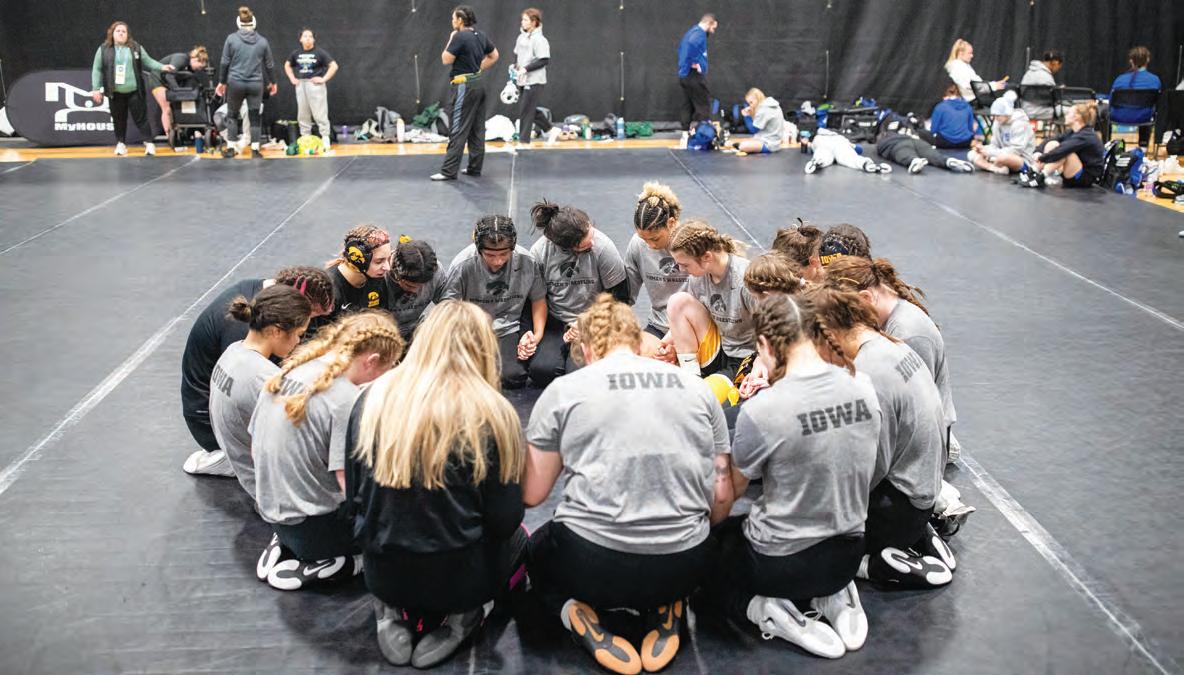
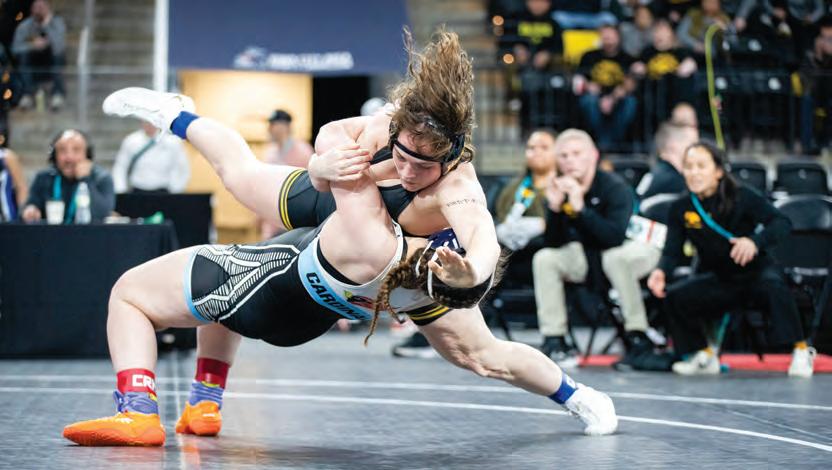
Emma Calabro and Isabella Tisdale | The Daily Iowan
(Top) The Iowa women’s wrestling team gathers before session one of the National College Women’s Wrestling Championship at Xtream Arena in Coralville. 2025 marks the last year before Iowa transitions to the NCAA tournament with its first year sanctioned coming in 2026. (Above left) Iowa 180-pound No. 4 Naomi Simon wrestles North Central College No. 5 Brittyn Corbishley during session two of the National College Women’s Wrestling Championship at Xtream Arena in Coralville. Simon defeated Corbishley by a 9-6 decision and placed third, earning an All-American status. (Above right) Iowa head coach Clarissa Chun directs Iowa 180-pound No. 4 Naomi Simon during session two of the National College Women’s Wrestling Championship at Xtream Arena in Coralville. Chun has been head coach since the program’s conception in 2022. (Beside) An official referee holds up Iowa 160-pound No. 1 Kennedy Blades’ hand after winning a title match against McKendree Kaylynn Albrecht during session four of the National College Women’s Wrestling Championship at Xtream Arena in Coralville. Blades defeated Albrecht by technical fall, 10-0. Blades was also named the tournament’s Most Outstanding Wrestler and finished her season undefeated with a 25-0 record. (Bottom) Iowa 145-pound No. 1 Macey Kilty accepts a national title during session four of the National College Women’s Wrestling Championship at Xtream Arena in Coralville. Kilty defeated North Central College and Iowa transfer Bella Mir by a 7-2 decision and finished out her season undefeated, 28-0.
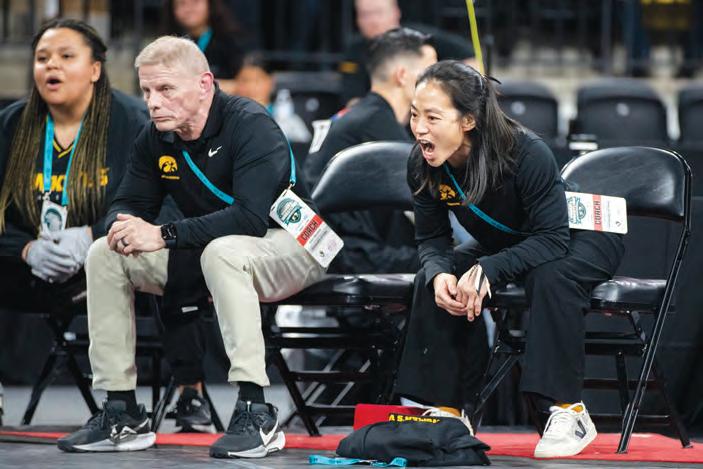

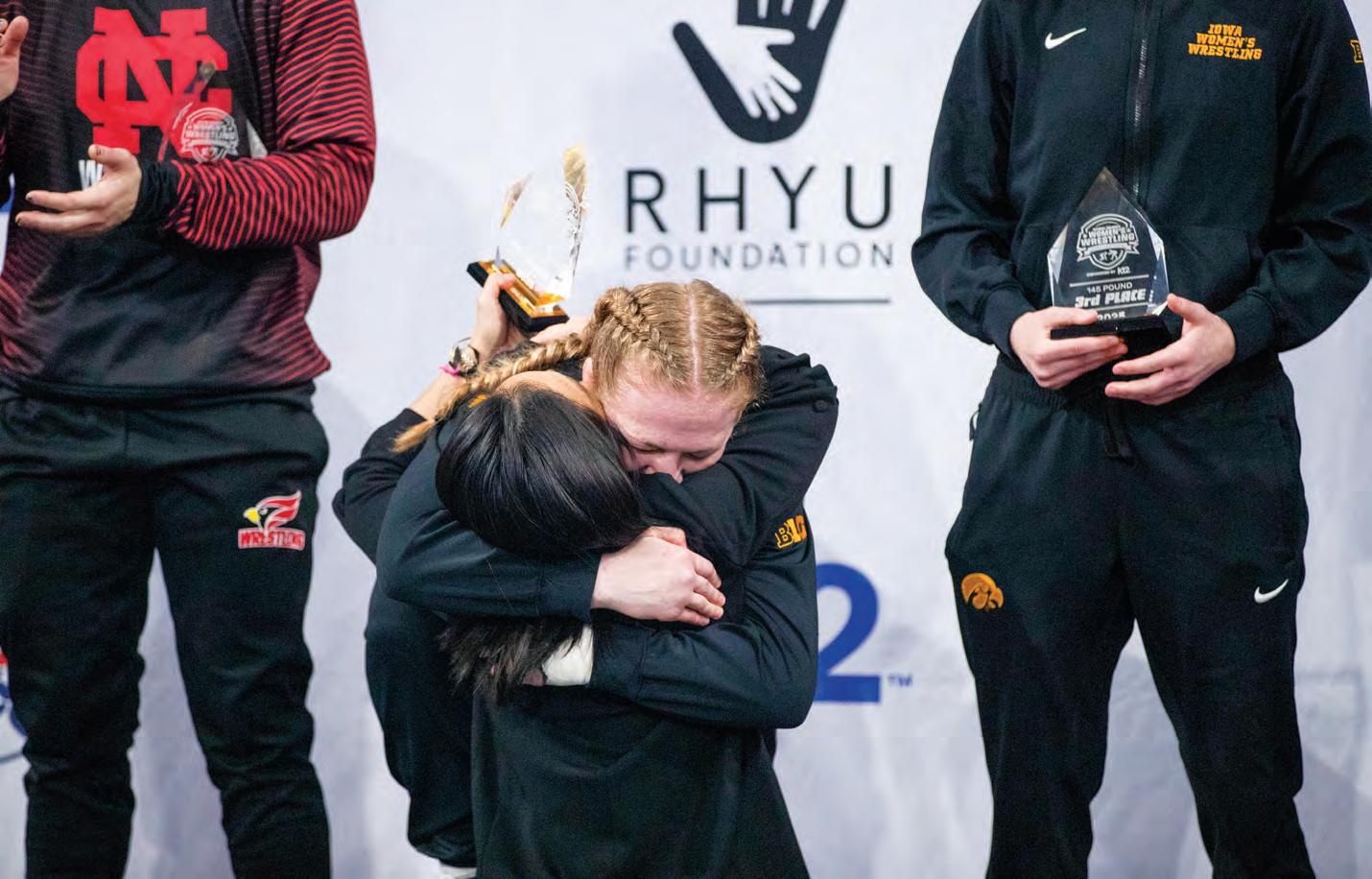

‘Cougar culture’ glamorizes Hollywood’s ageism
American cinema recycles the same situations and tropes in stories depicting older women. These indulgent movies try to hide this blatant ageism under the guise of incessant and objectifying sexualization.
How politics stitches into the fashion industry
Recent trends popping up in online spaces have highlighted the growing political divide seen in fashion.
Kyrsten White Arts Reporter
Lily Kopp Arts Reporter
TikTok users may have noticed a new trend on their most recent scroll — one that pits what people consider conservative and liberal makeup against each other, sparking the latest intense online debate.
There have always been different trends from each side of the political spectrum, but recently, these contrasts have become a hotly debated topic on social media. This tension mostly started with Suzanne Lambert’s video calling Republican users on TikTok who were commenting on her content. After that four-minute video, satirical
posts began appearing left and right, each side calling the other out on how they put on makeup or what they wear. Despite this seemingly random trend, there is precedent for politics bleeding into inconsequential online content.
Mike Draper, the founder and owner of the clothing store RAYGUN, believes there has always been some sort of divide with nonpolitical things. But he noted how most of it starts with the actual brand.
“There’s always been, in the world of branding, a political bend,” Mike Draper said.
A brand typically does not go into its creation as if it wants to be on either side of the political spectrum, but it commonly tends to lean one way or the other after a while.
“If I were going to drill down and get into why it’s now overly political, I’d say even something like Patagonia has always





Ways to enjoy break in IC
Take advantage of the refreshingly empty campus with these different events happening next week.
Is Terbuculosis: The History and Persistence of our Deadliest Infection.” The “Fault in Our Stars” author will be accompanied by novelist and poet Kaveh Akbar.
been environmentally focused,” Draper said. “But it was kind of like, this is how we want to set up our company. And it kind of stayed within that.”
He also acknowledged many of the reasons why fashion brands do this. With much of the population believing their elected officials do not take the proper action to keep progressing the country forward, they usually turn toward companies to try and fill that gap.
“People look towards anything to make progress. Before, political progress was left to politics in a lot of senses, but now everybody’s like, ‘What’s the company doing for the cause? What are these celebrities doing for the cause? What are these musicians doing for the cause?’” Draper said.
Many social media users have also been using their power as consumers to influence companies to “put their money where their morals are.” This is especially prominent in downtown Iowa City, where many small businesses are unafraid to display their political affiliations.
Faith Odhiambo, a sales associate at the local boutique Pitaya, talked about the difficult part of shopping based on your morals, especially for college students.
“Companies that aren’t as sustainable or aren’t supporting any good are morally corrupt. These companies are not afford-
able,” Odhiambo said. For Odhiambo, fashion is how she expresses herself and one of her biggest interests in life. She said people can use what she is wearing to make assumptions about who she is as a person, which she claims are correct more often than not. Similarly, Odhiambo said fashion trends tend to reflect what we are experiencing as a society.
However, in our modern age of social media, trends tend to cycle quickly. Memes, dances, and fashion trends come and go, so it’s hard to keep up with modern fashion trends.
“I feel like trends come back because we’re reminiscing a time where things weren’t how they are now,” Odhiambo said.
Odhiambo recalled this past summer, dubbed “Brat Summer” by Charli XCX, characterized by club music, short skirts, and bright green outfits. During the election cycle, social media users even created memes of Democratic presidential candidate and former Vice President Kamala Harris over songs from “Brat,” consequentially politicizing Brat Summer.
“Somehow that became a political thing, but it was just an aesthetic of … the type of summer people wanted to have and dress for,” Odhiambo said.
IC Public Library used book sale draws literary fans
The public library’s accumulated collection of books was sold to the public rather than just thrown away.
Kyrsten White Arts Reporter arts@dailyiowan.com
While walking through the Ped Mall on a bustling Saturday morning, many book readers found their way to the Iowa City Public Library for its used book sale.
Sponsored by the ICPL Friends Foundation, books of a variety of genres and techniques were on display. The wide breadth of options allowed anyone the chance to find something they would enjoy.
Katie Roche, ICPL Friends Foundation development director, helped with the collection of the used books and the sale setup. She also was one of the many faces assisting with checking people and their novels out.
“We have ravenous readers in our community who are suggesting materials, who are speaking to the people who buy the books at the library and saying, ‘Hey, can we get more of this book?’” Roche said.
Living in such an energetic literary city, there are always people looking for more things to read. Holding events like these helps those in the community searching for new materials further their reading and writing abilities.
“Anytime you can get a book into someone’s hands, it’s a good thing,” Roche said. “I love seeing the kids coming in, selecting whatever material they want, talking to their parents about why they want to get that book and bring it home.”
Kellee Forkenbrock, a librarian from the North Liberty Library, was among the many people who attended the sale. She also finds that events like these encourage people in the area to get out and read more.
“I love the energy of a book sale,” Forkenbrock said. “Everybody’s here to get their books and talk to their neighbors and be part of the community.”
Forkenbrock pointed out how these
events not only help to support those in the area but also the library itself. With multiple legislations being introduced to Iowa’s House and Senate that go against funding for public libraries, it is important to continue gatherings like this.
Another attendee of the event, Glenn Houlihan, also mentioned how important it is to continue providing money to the library.
“I think it’s an incredible resource, and I’m so glad it exists. It needs to be a priority to keep increasing funding for it,” Houlihan said.
As is the case in other Pay-What-YouCan events, through this used book sale, the Iowa City Public Library can raise the money it needs on its own terms. This event specifically also allows the Friends Foundation to keep many books from being thrown away.
Allowing anyone from the community to come in and donate the books they may think they no longer need opens up the chance for books to stay in rotation in the reading community. Many people may think the only option for a book when they are done with it is to throw it away, but the library gives books a second chance.
All the books provided for this sale either came from a member of the public or the library itself. When a book is no longer circulating through the library, it also gets repurposed for this sale to hopefully find another home.
The number of books supplied by the loving community can be sold at gatherings like these in stores such as The Book End and Book Nook, located within the library. The Friends Foundation can also redistribute some of these books to other librarians within the area.
“I’m proud to say that we have robust circulation at the Iowa City Public Library,” Roche said.
'The Penelopiad' reveals a story that is seldom told
Spring Break is approaching fast. Excited murmurs fill lecture halls as students look forward to visiting family, flying away to a beautiful beach vacation, and more. Then, there are the less excited murmurs, the groans. Every spring break, Iowa City hosts students who are staying in town for the break. The campus runs empty, save for a few tumbleweeds and cricket noises. These Hawkeyes may live too far to fly home for break or have commitments around town. Whatever it may be, most don’t look forward to sticking around town for break.
If you’re one of those few, fear not. Here are some fun options if you’re staying back to make your week in Iowa City a vacation.
Live Music Friday at AlleyCat
Catch some tunes for Live Music Friday at AlleyCat on Friday, March 21, from 9 to 11 P.M. Additionally, if you happen to catch the singing bug, there is karaoke after the show for any brave fans. You can get tickets at the door, and there are food and drink options throughout the whole event.
An Evening with John Green
Remember CrashCourse from high school or middle school? Those animated videos you would watch on historic events or topics when you forgot to study for a test until the night before? Well, you can thank John Green for those. Englert Theatre will host the international bestseller on Friday, March 21, to discuss his newest book, “Everything
Lady Franklyn Improv Show
Willow Creek Theatre Company is Iowa’s professional improv team! On March 22, from 7:30 to 9 P.M, they will be performing at their home theatre. Purchase tickets online and enjoy an evening full of laughter and creativity.
Enjoy your favorite restaurant without the wait
Tired of always waiting around at your favorite downtown food spot? Enjoy getting to grab a quick to-go meal or take a table all to yourself for a nice, slow evening downtown.
Set up Shop at FilmScene
FilmScene has numerous events over break that you don’t want to miss. Some highlights include a showing of “Raw” as a part of FilmScene’s Pride series on March 18. “Thrust! The Pink Cut” (2022) will play on March 21, a screening to coincide with Late Shift at the Grindhouse. Finally, end your break with Shakespeare’s classic “Hamlet” compliments of National Theatre Live on March 23.
If you are staying back in your favorite college town this break, don’t settle for scrolling on the couch waiting for your roommates to come back into town. Take advantage of having the city to yourself, it’s not often that Iowa City isn’t packed to the brim with Hawkeyes.
The James Theatre showcases harsh realities.
Riley
Dunn Digital Editor riley.dunn@dailyiowan.com
“The Odyssey” is a story that has been told many times, rewritten throughout history to remark on the brave and treacherous exploits of the Greek hero Odysseus. The hero’s wife, Penelope, is looked upon in that story as a beautiful and pure woman who spends many years outsmarting other men to remain faithful to her beloved husband.
Penelope’s story from the 20 years she spent waiting for her husband is not talked about as often.
“The Penelopiad” tells that story, centering on the Queen of Ithaca and the twelve young maids with whom she was close. It is the maids, perhaps even more than Penelope herself, who shape Dreamwell Theatre's latest production.
“The Penelopiad” is a retelling of a novel of the same name written by Margaret Atwood and, similar to many Atwood works, it forces its audience to face uncomfortable truths. I particularly enjoyed this aspect of the show, as it illustrates that it is a story being told by women who are typically not allowed to speak up for themselves. Each male character is seen how the women would see him here, they’re not in the spotlight like in “The Odyssey.”
I was never once confused over who anyone was supposed to be and was only entertained by the differences in manner-
isms and speech patterns that would occur when the actresses would switch roles.
Another strength of the play is it does not shy away from portraying difficult content. Throughout the play, there are depictions of physical and sexual violence towards the woman as the suitors invade every aspect of their life.
The maids are powerless to prevent these acts from happening and — on the contrary — are told to keep silent about them.
Certain scenes throughout the show were purposefully difficult to watch. These women have been led to believe this behavior is okay, and they are being forced to remain silent, only to be later blamed for being “impure.” It is upsetting, and it is something that persists in modern-day life.
Penelope herself is someone toward whom I feel both anger and sympathy. Anger because of her actions toward the maids as she uses them for her clever schemes. But also sympathy, for the heartbreak she goes through and the unimaginable position she is forced into.
Emma Bibb, who plays Penelope, is the only actor who has but one role — that of the titular Queen. Penelope is clever, funny, calculating, and haunted — all emotions that come through due to Bibb’s acting.
And though Penelope is the main character, and though this story is named after her, she can never quite forget the other women who walked alongside her.
Ageism permeates throughout pop culture
Haya Hussain Arts Reporter arts@dailyiowan.com
Charlie Hickman Arts Editor charlie.hickman@dailyiowan.com
When picturing the perfect protagonist, people often imagine someone young — either in their late-20s or mid-30s, or 16 and coming-of-age. Elderly main characters are few and far between. Situationally, their lives are usually already domesticated by their children and partners. Take “Everything Everywhere All at Once.” Protagonist Evelyn Wang is in her late 50s, fighting against the worldly order of love and the estrangement of her daughter and husband.
Another popular film starring an elderly character, “A Man Called Ove,” follows a grumpy 59-year-old who begrudgingly forms an unlikely friendship with his neighbors.
Robert De Niro’s comedy film, “The Intern,” is about a sweet, retired elderly man employed by a fashion company who takes time to learn from younger people.
In all of these examples, romance is already present in these characters’ lives long before they turn the leaf of middle-age. The love stories stereotypically associated with a film protagonist have already occurred.
First-year student Madeline Anklam notes this isn’t always the case for the elderly. Employed at a senior center, she sees many people pursue romance later in life.
“Sure, they talk about their ex and late partners, but some have also remained single all their lives. You can still explore romantically as an elder,” she said. For Hollywood, however, sex is out of the question. The media industry curdles at the thought of older people having sex.
Fourth-year University of Iowa student Laura Otting has noticed this, too. Otting has encountered many movies with aged main characters in her experience as a member of the Women in Film club at the UI.
“Older generations get overlooked when it comes to love, romance, and sex in pop culture,” Otting said.
The recent A24 hit, “Babygirl,” in which Nicole Kidman portrays 57-year-old Romy Mathis, challenges this usual notion of sex on screen. The film became somewhat of a cultural phenomenon in December 2024 when it premiered.
Critics like Whitney Friedlander of Variety magazine praised the film for its subversive subject matter. In a year full of films like “The Substance,” which seek to upend gender stereotypes on screen, Friedlander finds “Babygirl” to be the most sexually liberating. Kidman’s character is a sexy,


controlling CEO being seduced by her 25-year-old intern Samuel. Those who are more negative toward the film criticize it for its glamorization of the age gap romance rather than celebrate the depiction.
The age gap aside, critics say the film is not a good representation of the elderly.
Following the same tropes elderly leading characters have been restricted by for years, Kidman’s character has a pre-established relationship with her husband and doesn’t get much of an arc worthy of a film protagonist.
“The reason why ‘Babygirl’ didn’t work for me is because it didn’t feel like an actual exploration of the female erotic fantasy. It felt very hollow and surface-level,” Otting said. “When you see a lot of female actresses and characters put in these roles, you have to ask, ‘Are they doing this to make a statement, or are they showing boobs to show boobs?’”
Critics like Otting claim “Babygirl” isn’t as different as everyone thinks it is. It exacerbates pop culture’s stereotypes of the elderly.
The depiction of older folks in films has influences far beyond Hollywood. Negative age stereotypes and perceptions can have detrimental effects on the mental health, hirability, financial security, and social isolation of older people.
According to a study done in 2020 through the World Health Organization, an excess of $63 billion is spent annually on health conditions relating to these detrimental effects. Any form of prejudice ends up leading to costs, but there are far fewer polices and regulations in place around the world to combat ageism.
Films like the previously mentioned “The Intern” depict elderly workers as doting sources for comedy. De Niro’s character in the film is a retiree who gets a gig at a tech startup after they create a specialized senior intern position to perform progressiveness.
As critics of the film were eager to point out after the film released in 2015, the end of the film reinforced ageist stereotypes in the workplace.
De Niro’s character leaves his position and returns to retirement, where he is seen living a more peaceful life, and the film portrays this as the correct decision, casting him as an outlier in the workplace but comfortable alone at home.
a comeback in film and is perpetuating stereotypes that older women are only physically appealing when a younger counterpart deems them so.
“It’s honestly creepy. People typically date in their own ranges, and it’s reasonable to say that your attraction develops with your age,” Anklam said. “In real life, it’s predatory if a 60-yearold is with a 20-year-old. That, or people make comments like: ‘Oh, you’re in it for the insurance money.’ That’s also harmful to how the elderly are perceived.’” This depiction exacerbates the anxiety around aging and older body image disturbance.
Anklam said. Although Romy isn’t very “vulnerable” in the sense that people in need of a senior center or living home are, she has a lot missing from her life. This makes her emotionally volatile, and the comfort that Samuel offers her is purely sexual. Even though he falls in love with her later, the lead-up to this is not contextualized by traditional and affectionate romance. The focus of the film is not her personality, looks, or journey. It’s her age gap with Samuel and the reversal of their roles. The movie is littered with resignifications of age that comment on this.
For example, the film’s feature song “Father Figure” juxtaposes Samuel to Romy’s priest or authority. Controlling an otherwise independent, older woman is what drives his attraction and the success of their exchanges.
“The problem with the sexualization of older women is when the relationship they’re in with younger men is not about their emotional connection, but their age gap,” Otting said.
Instead of exploring the deep psychological and emotional nuances of being in a relationship with an older partner, most depictions prefer to take the fetishization route. Unfortunately, women in film have been facing hypersexualization since the dawn of cinema. Only now, elderly characters seem to be receiving more attention.
Edited by Will Shortz No. 0205

“Older generations get overlooked when it comes to love, romance, and sex in pop culture .”
Laura Otting University of Iowa fourth-year student
While the grumpy, isolated old man stereotype is likely the ageist trope most people are familiar with, “cougar culture” has been prowling the social conscious as well.
“Your mom” jokes have been a staple of school lunch tables for generations. The recent shift to joking about “MILFs,” a term sexualizing older women, is indicative of the shift in popular culture. Movies like “Babygirl” or Anne Hathaway’s “The Idea of You” centralize age-gap relationships and are completely marketed on the sexualization of older women.
Cougar culture is making
“If you want to look at cougar culture, look at Adam Sandler’s opening sequence in ‘That’s My Boy.’ It’s something that’s been perpetuated since the ‘70s and ‘80s. The young boy wants to sleep with the older hot momslash-teacher,” Otting said.
Antonymous with the Lolita effect, cougar culture is a phenomenon often obsessed with conquering and controlling older people. For example, Samuel gets off on the power his sexual extortion has over his otherwise empowered boss, Romy, in “Babygirl.”
“That’s what abuse of the elder is. You know they are vulnerable and, in some cases, unable to stand up for themselves when they’re being manipulated,”
Not every film featuring elderly characters falls into stereotyping, though. Recent films like “Thelma” tackle age with humor and, in the case of this John Wick-esque comedy, blood. June Sqiubb starred in “Thelma” at 95 years old, an incredible feat. The story works to upend our expectations of elderly people and sees Thelma kicking ass on her motorized scooter rather than settling for the pitfalls of society’s expectations for elderly women.
In a more realistic depiction, Meryl Streep portrays a powerful woman at the head of The Washington Post in the 2017 film, “The Post.” While male characters around her try to make decisions on her behalf and constantly doubt her intelligence, Streep’s character, based on the real life Katharine Graham, follows her instinct and leads the publication through a difficult time.
While these two examples do reject stereotypes, they are the exception to the pattern. The pop culture we consume has reduced the elderly to one of three tropes: happy and settled, grumpy and widowed, or seductive and malleable. Critics of this trend wouldn’t classify these as characters, rather ageist caricatures.



2025 Oscars sets new tone for awards
The film industry has evolved, as seen after a historic night awarding indie films. Conan O’Brien hosted the show on March 2 with both humor and celebration.

Charlie Hickman Arts Editor charlie.hickman@dailyiowan.com
The same debate around the Oscars occurs every year: Do they matter?
As a psycho who spends far too much time reading about and engaging with contemporary film culture, I sure hope they do.
This year’s 97th Academy Awards finally offered evidence to support my hope for the importance of the show, thanks to a record-breaking statistic.
Every winner in the main acting awards — Best Picture, Best Director, Best Animated, and Best International Feature — was an independently financed film made outside of the Hollywood studio system.
I believe that is a sign of the future of the film industry. Gone are the days of the newest Disney animated film winning every year and the latest studio-produced period drama sweeping all of the production awards. These awards were widely distributed to a varied assortment of films.
While it is fun to tune into the show and root for your favorite blockbuster like “Wicked or “Dune: Part Two” this year, I always appreciate the Oscars’ capacity to introduce films to a wide audience.
My parents are not avid movie watchers, but they make an effort to watch as many Best Picture nominees as they can every year. Films like “I’m Still Here” and “Flow” winning major awards is indicative of the Oscars at their best: platforming interesting work while still celebrating the best films of the year.
Most of the Oscars ceremonies I’ve seen have felt less like a celebration and more like a chore. Thanks to host Conan O’Brien — one of the funniest people on the planet — the earnest tone returned. My favorite bit of his was a prerecorded sketch about getting people off their couches watching movies and back to the theater, a sentiment I love to see normalized on national television.
Perhaps it was the laugh-out-loud appearance from Adam Sandler, Mick Jagger, or Martin Scorsese, but I was shocked by how spirited everyone seemed. Nominees were cordial and thankful toward each other, most
speeches were the perfect amount of sappy, and the sentimental messages seemed honest.
Sean Baker’s speeches particularly stood out. Baker won four awards as editor, writer, director, and producer of “Anora.” In his speeches, he sang the praises of independent cinema and the power of movie theaters.
“No Other Land” winning Best Documentary Feature was another highlight. Despite not having distribution in the U.S., this platform will hopefully make more people aware of this vitally important film about the forceful displacement of Palestinian citizens under the Israeli government.
The night wasn’t without its hitches — it wouldn’t be the Oscars without a few cringeworthy moments after all.
After winning Best Original Song for “El Mal” from “Emilia Perez,” songwriters Clement Ducol and Camille began singing a song from the film. The pair awkwardly sang for far too long and even tried to get the completely silent audience to join in. It was a comically awful moment I sort of loved.
Instead of performing any original song nominees, the Academy elected to hold a musical funeral for the 007 franchise. Following the news that the rights to James Bond were sold to Amazon, three of the most iconic theme songs from the film series were performed by Lisa, Doja Cat, and Raye after a “Bond girl-esque” dance number from “The Substance” star, Margaret Qualley.
While the performances were good, I was extremely confused by this decision. Why was it 10 minutes long? Why not get the original singers? Why this year?
Another musical mishap occurred during the In Memoriam segment. During a touching tribute to Gene Hackman, Shelly Duvall, and the legendary David Lynch, the band played Mozart’s “Lacrimosa,” an incredibly ominous composition that threw off the sorrowful tone.
For the first time in a while, this year’s show got me more hopeful for the future of the art form of film.


